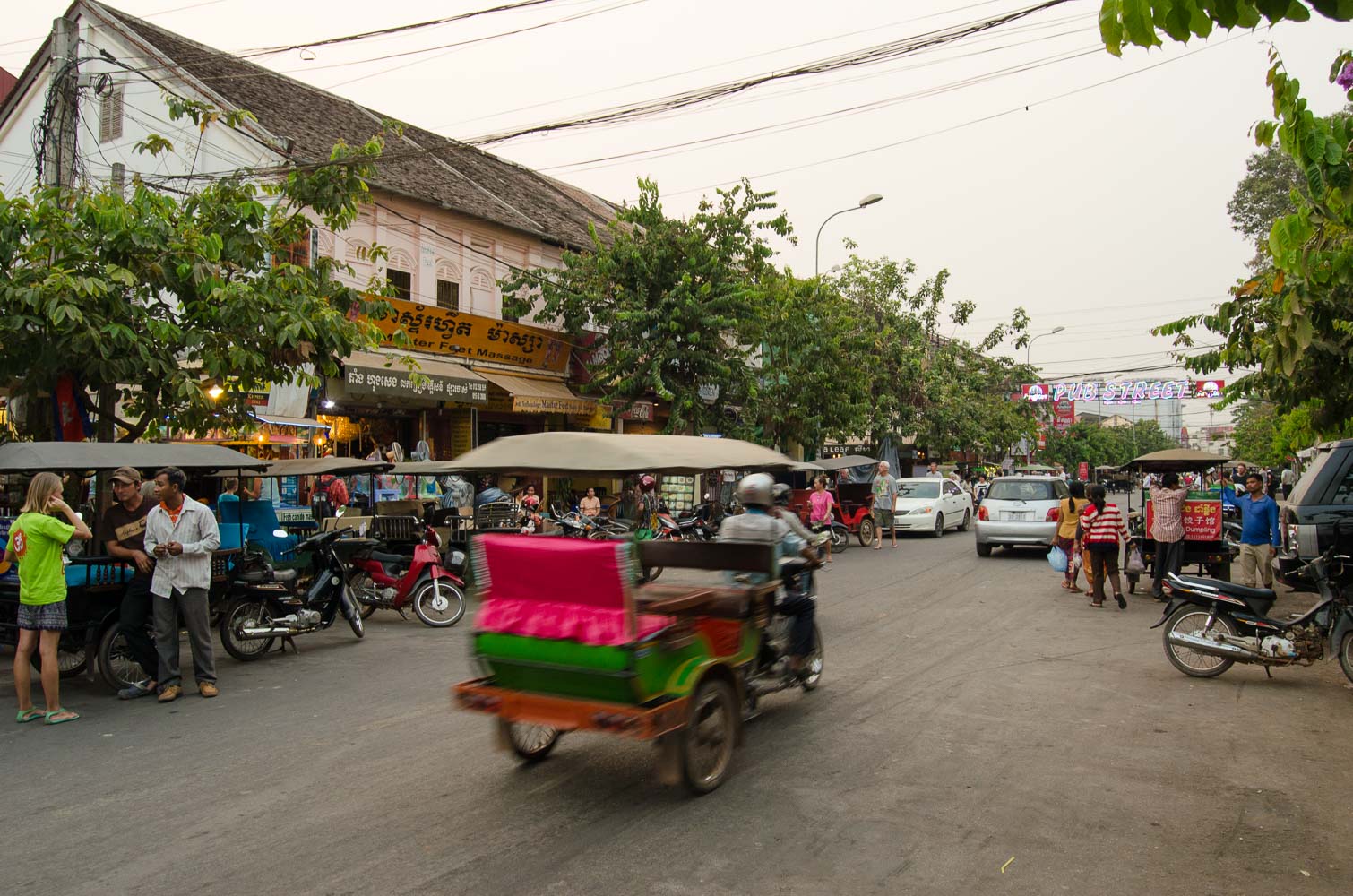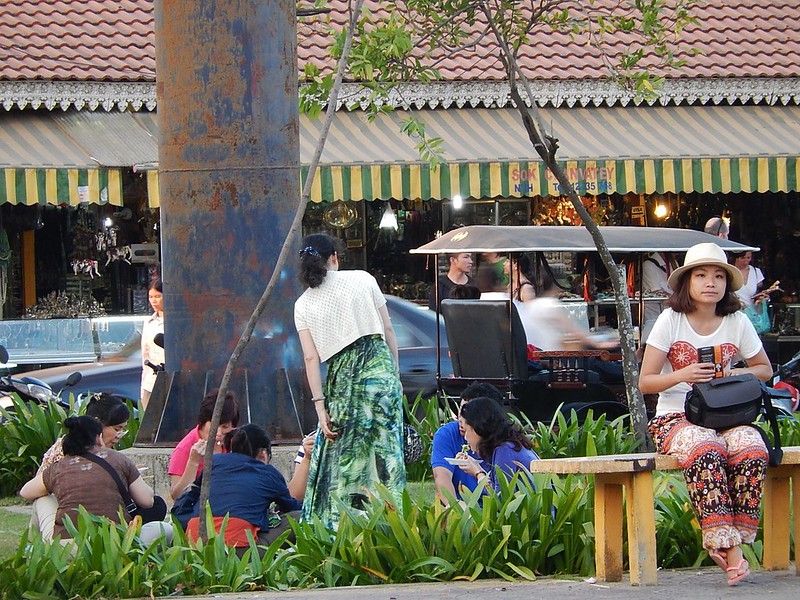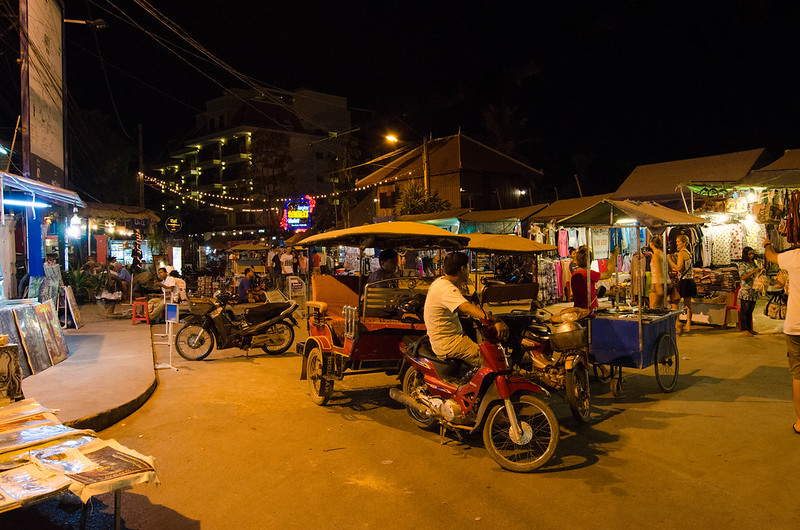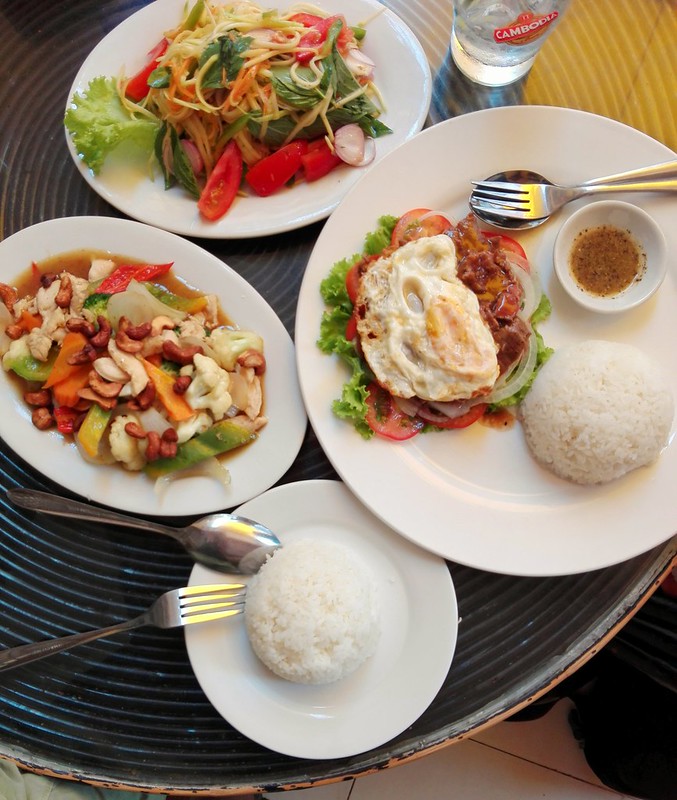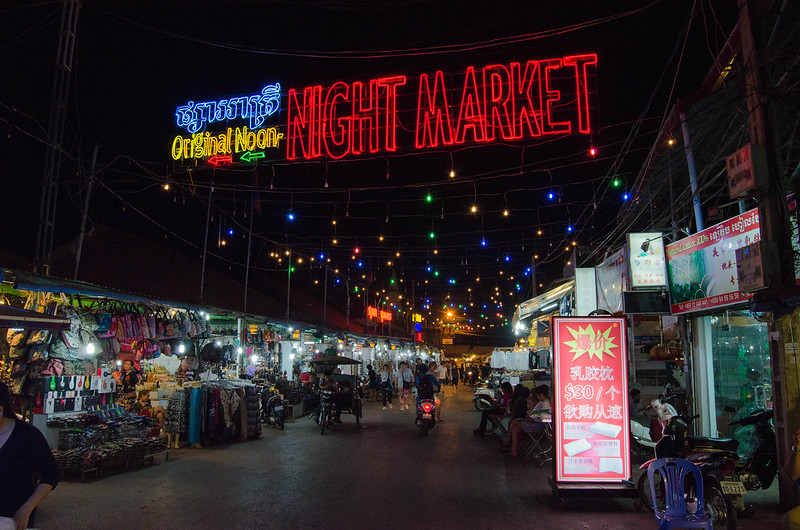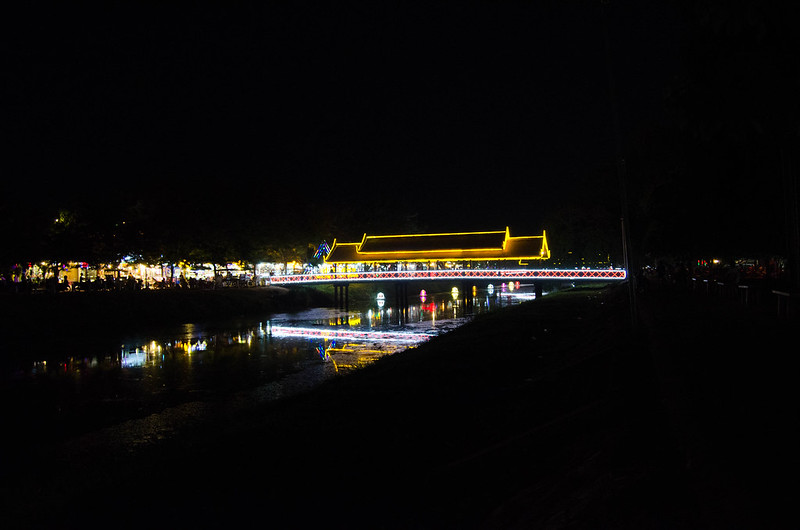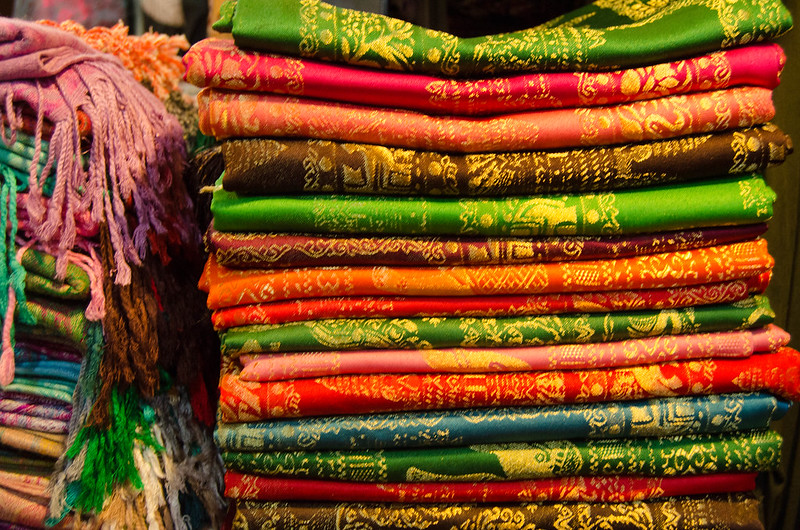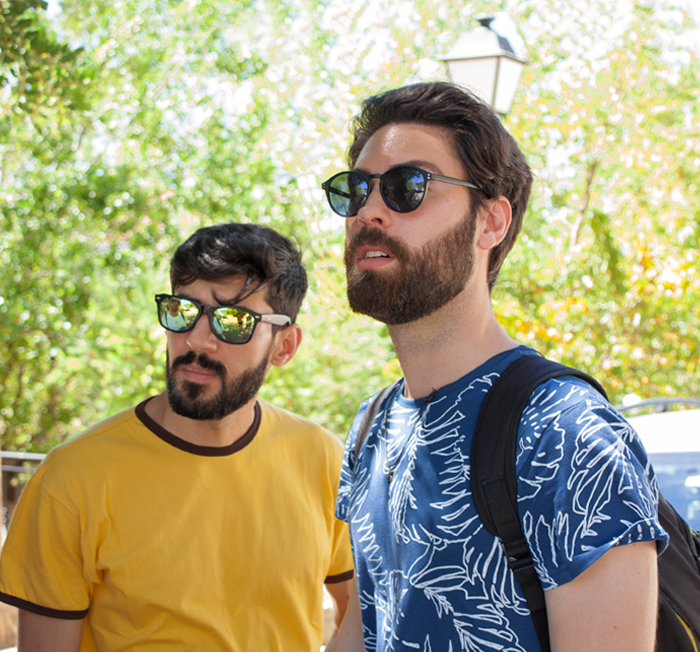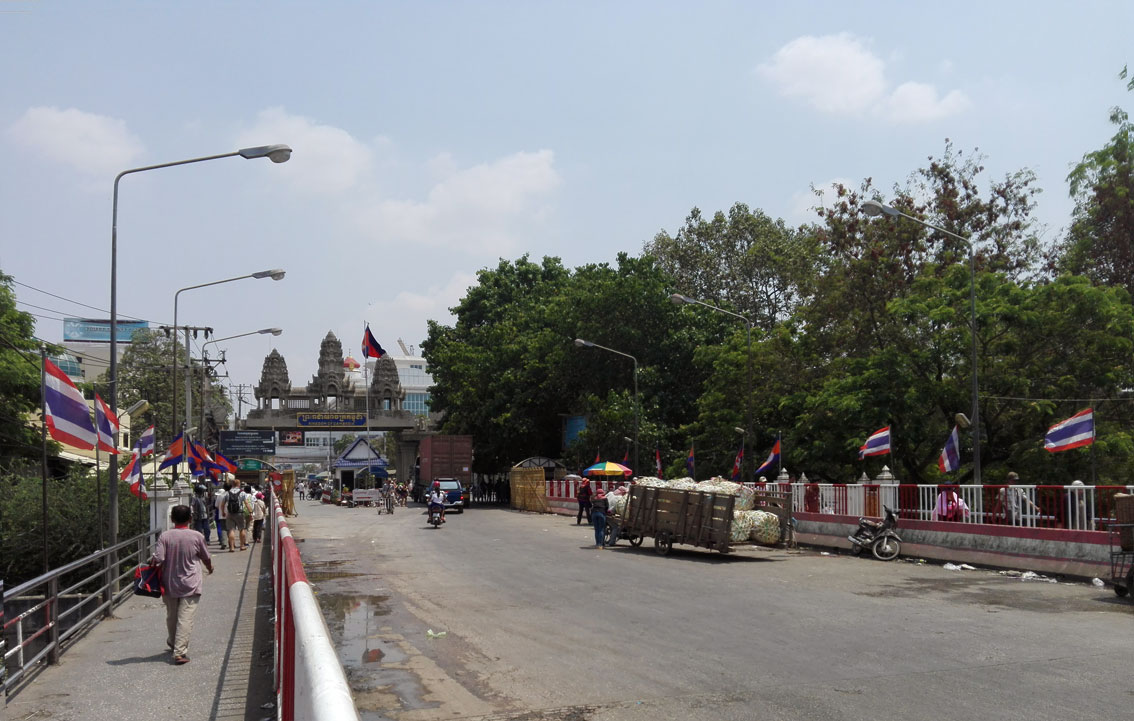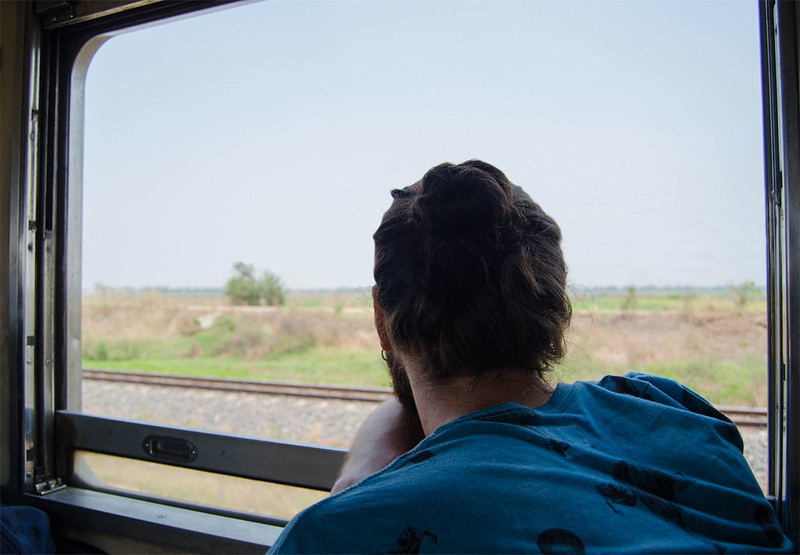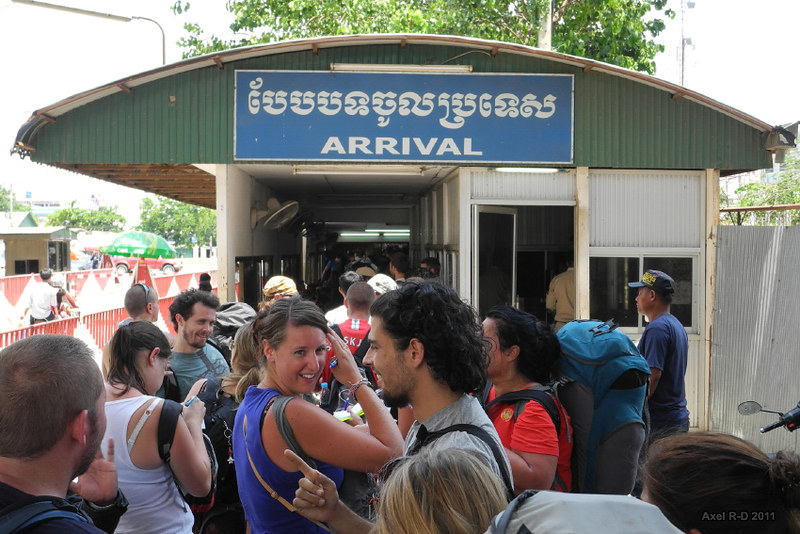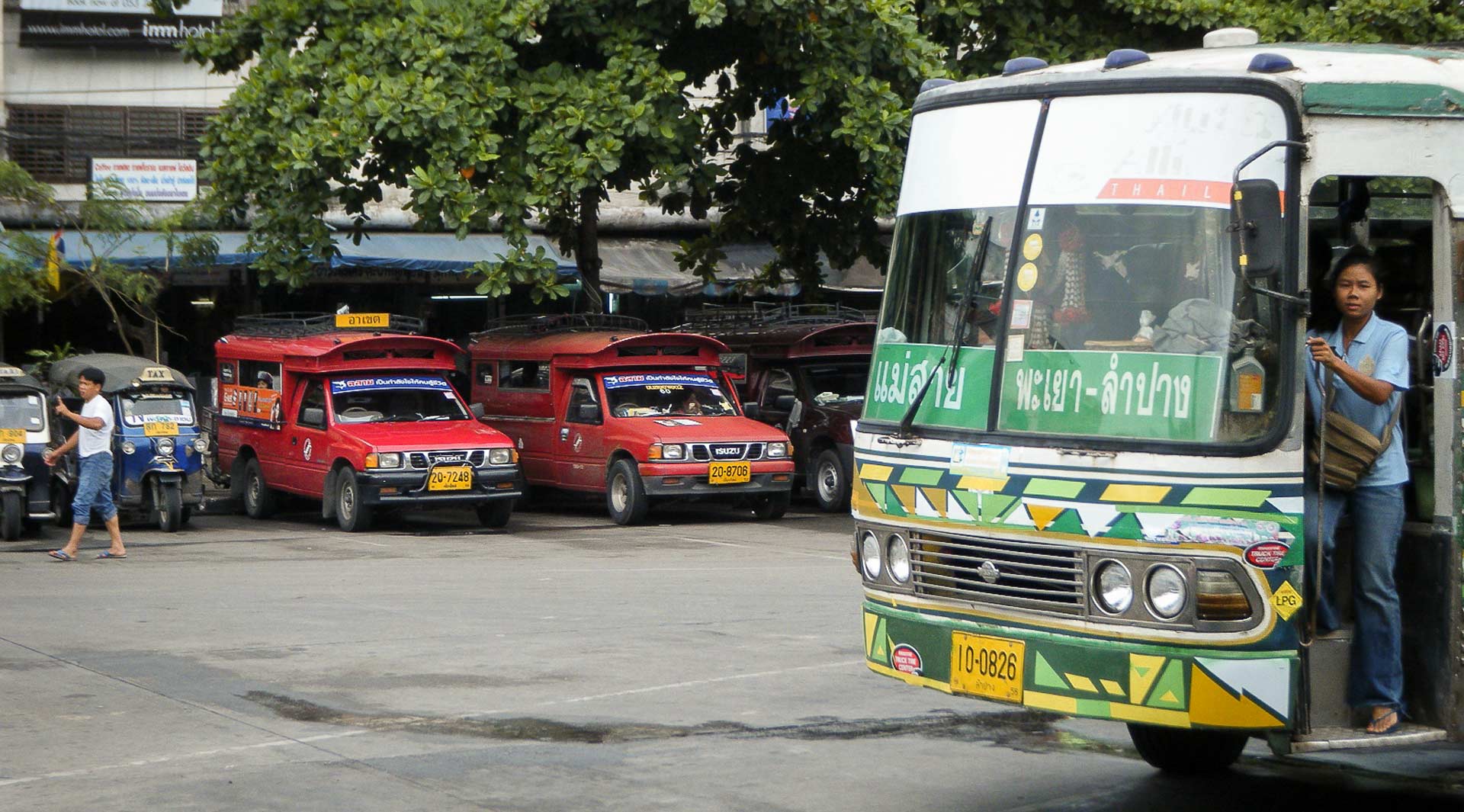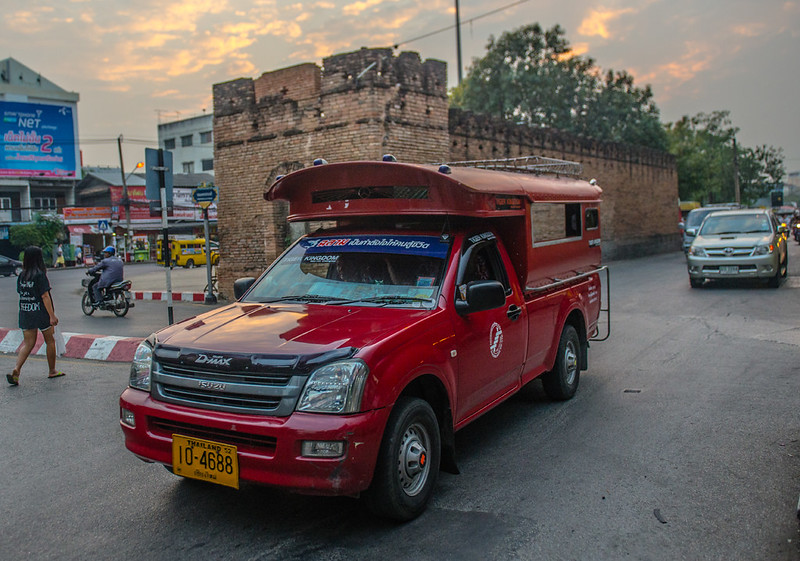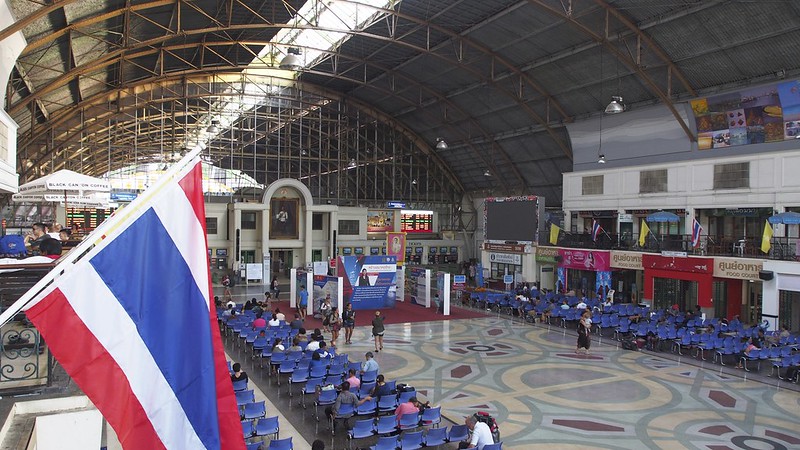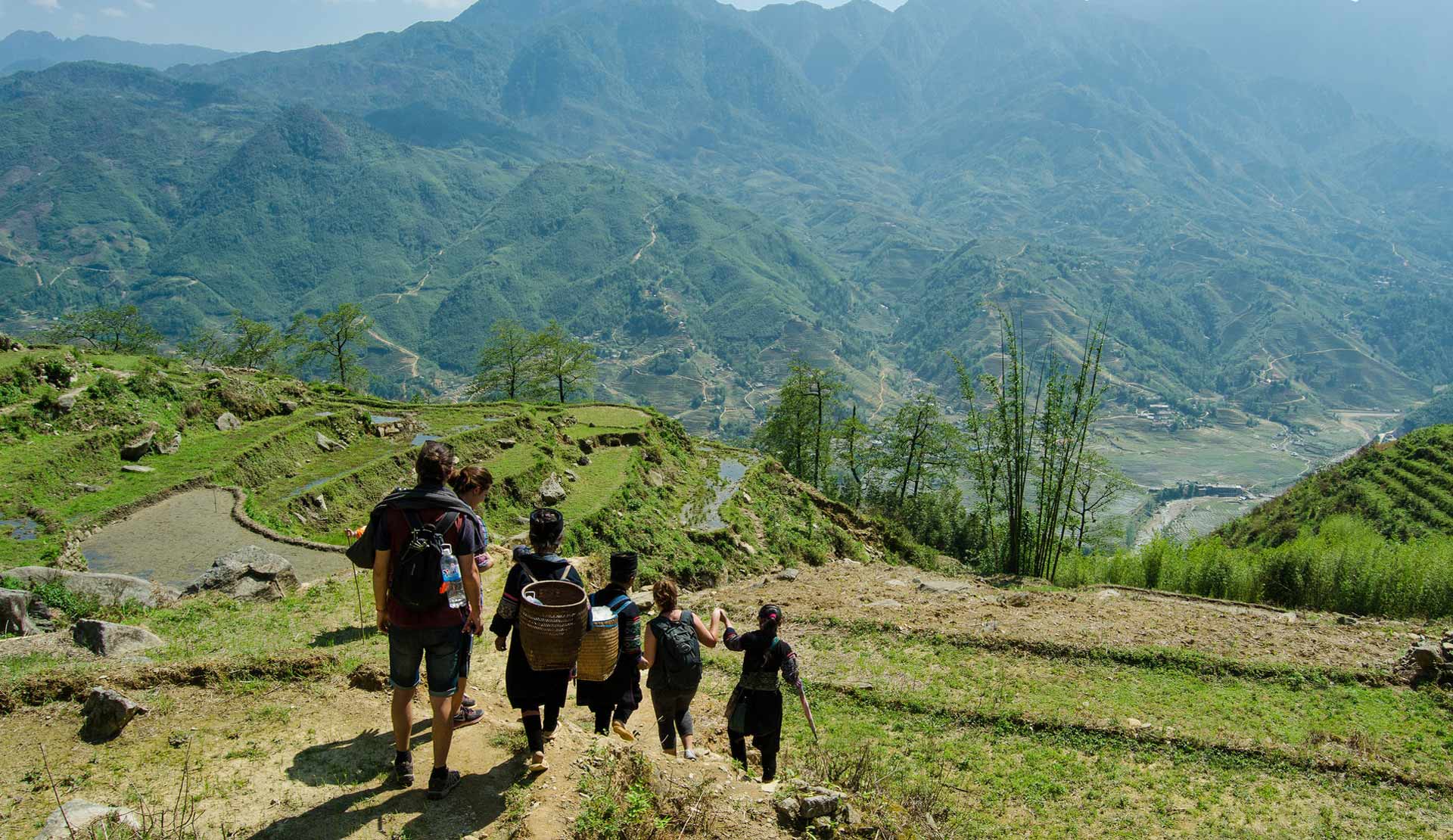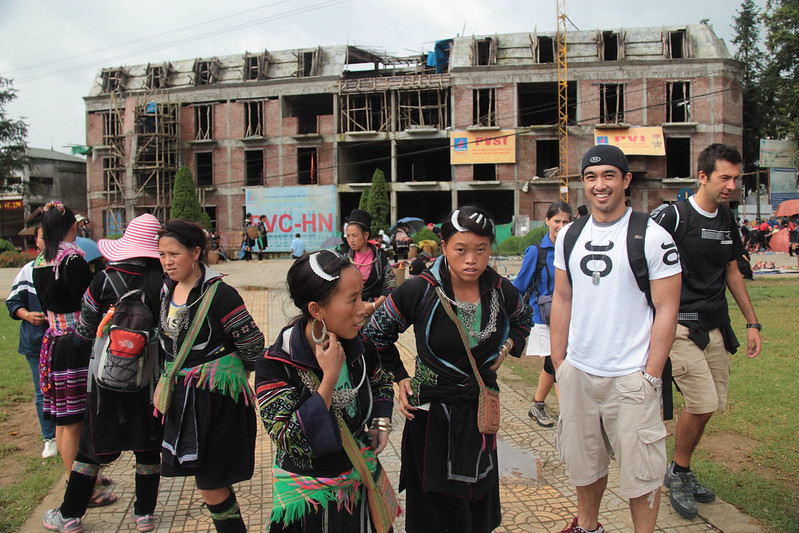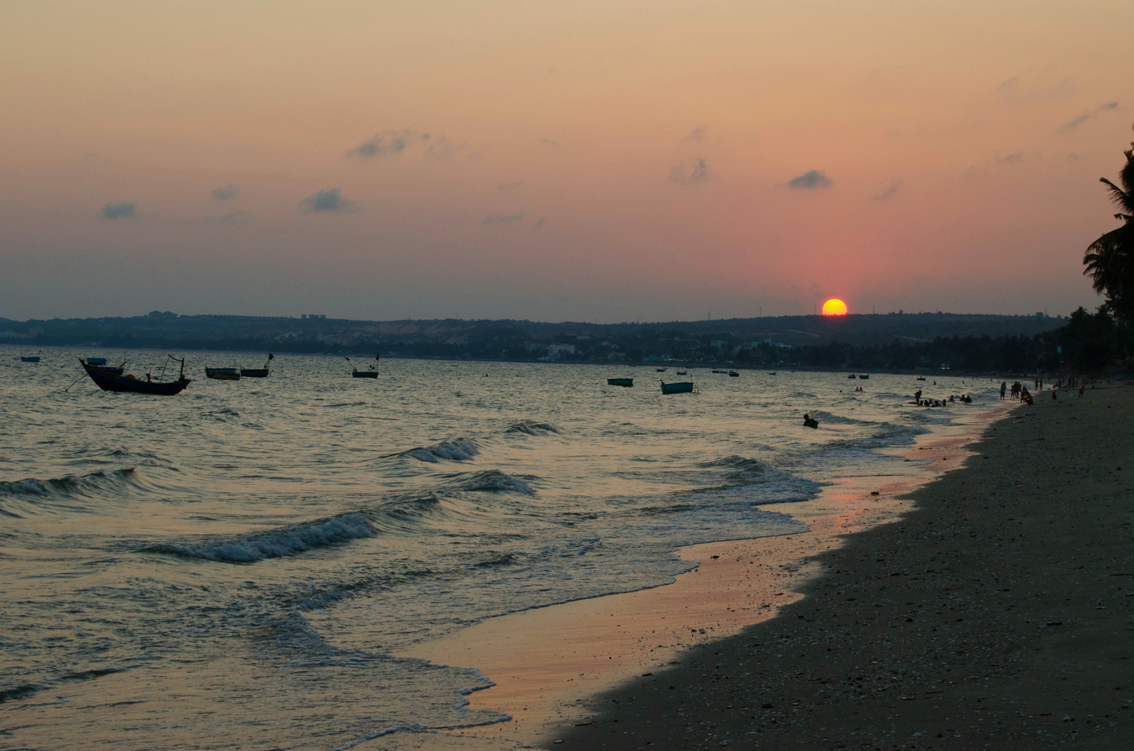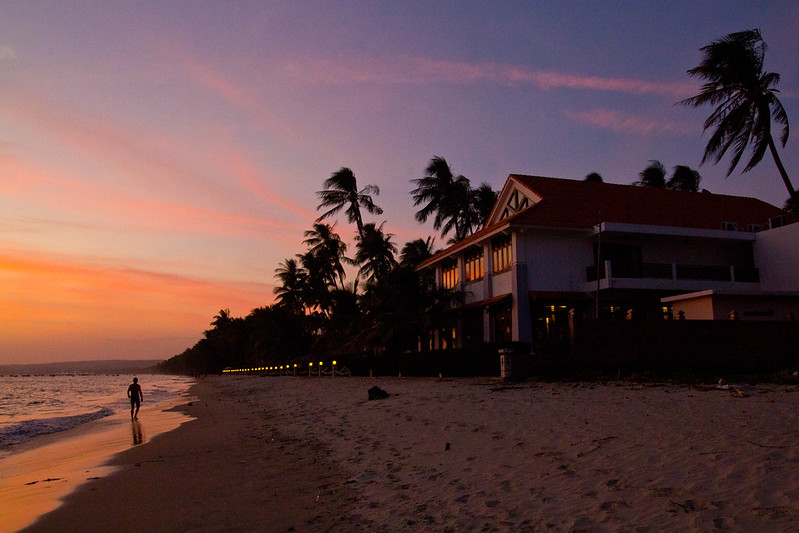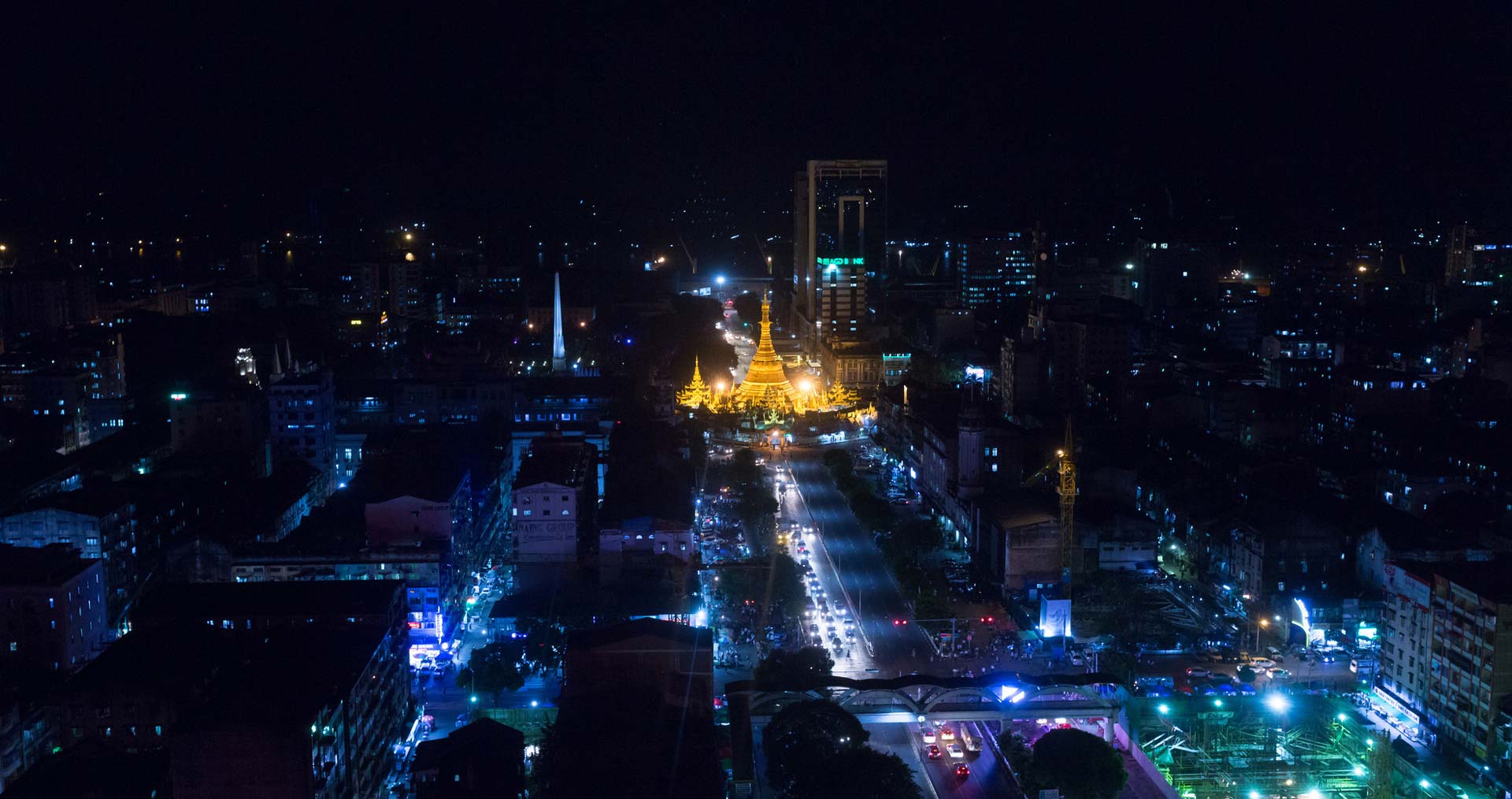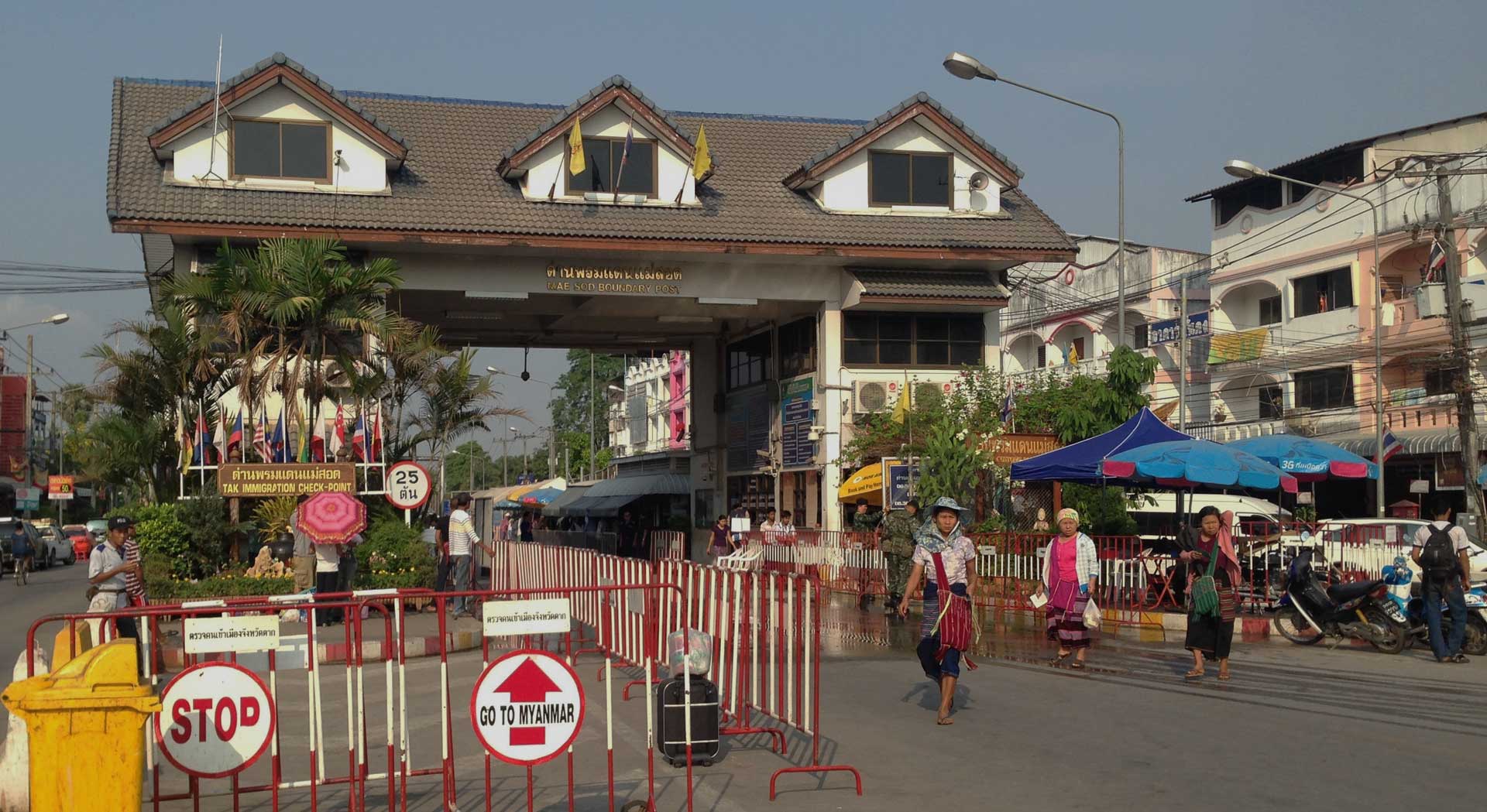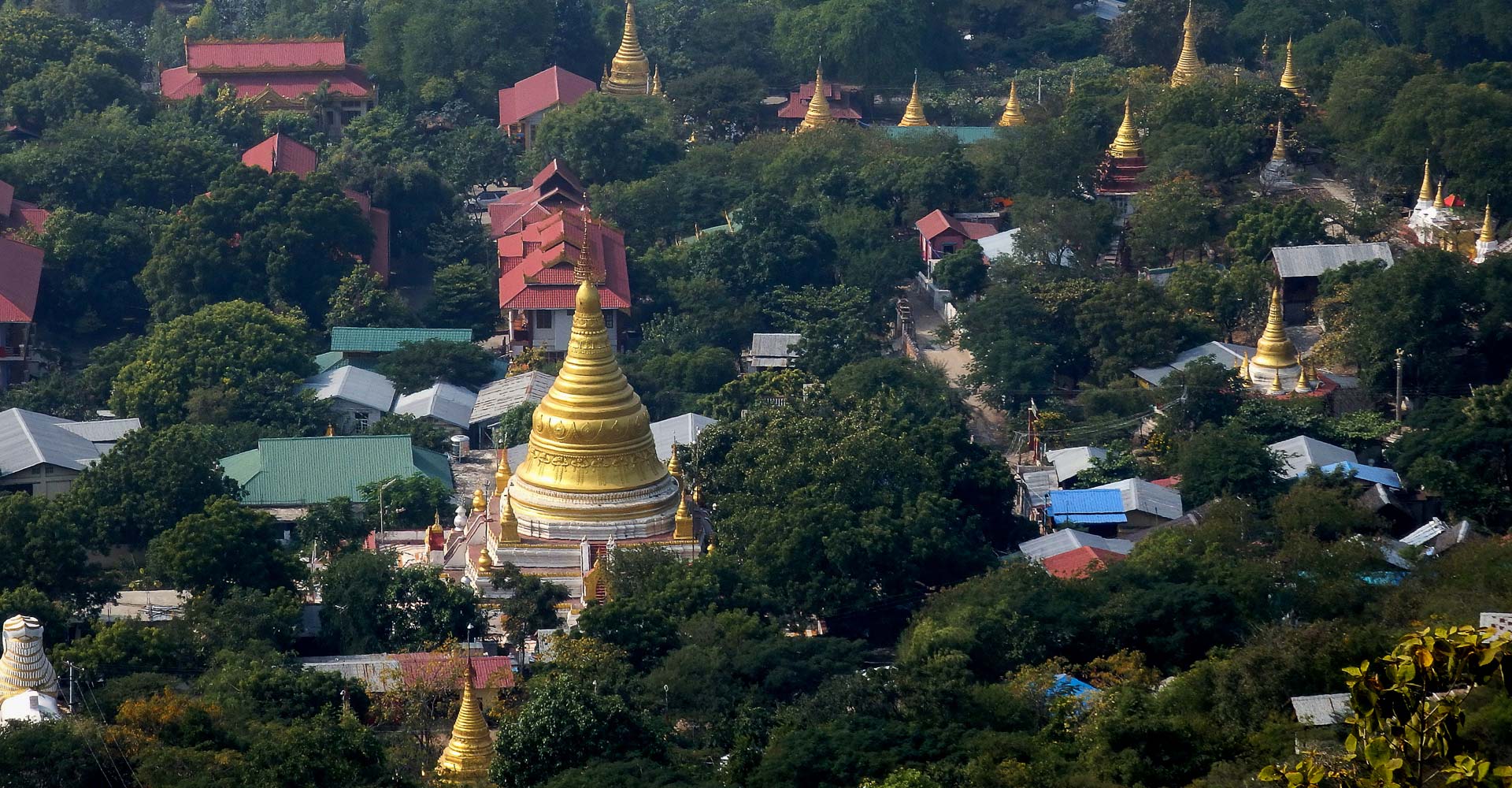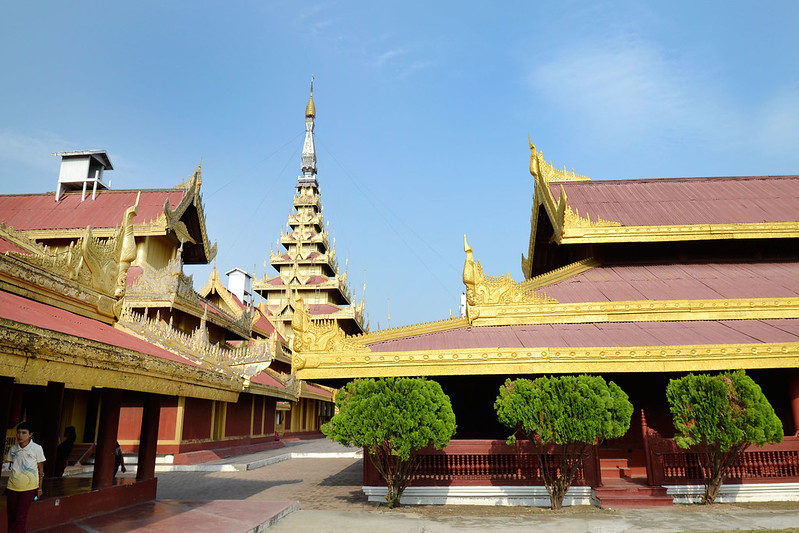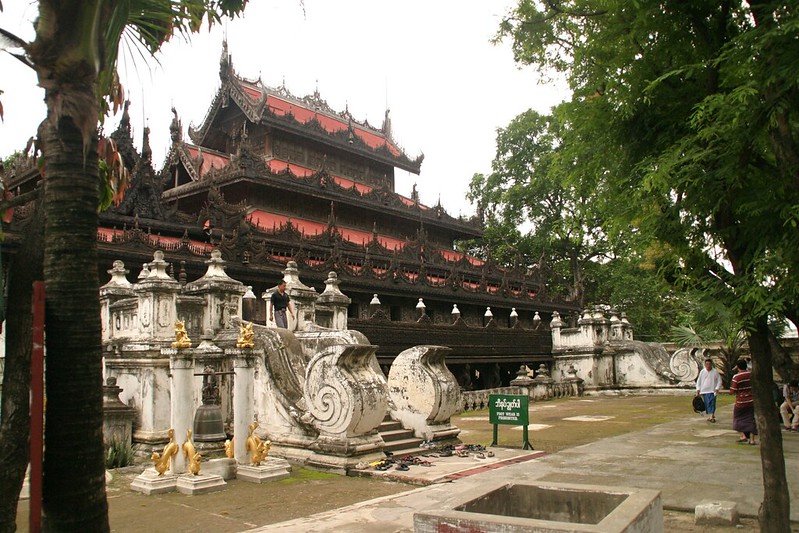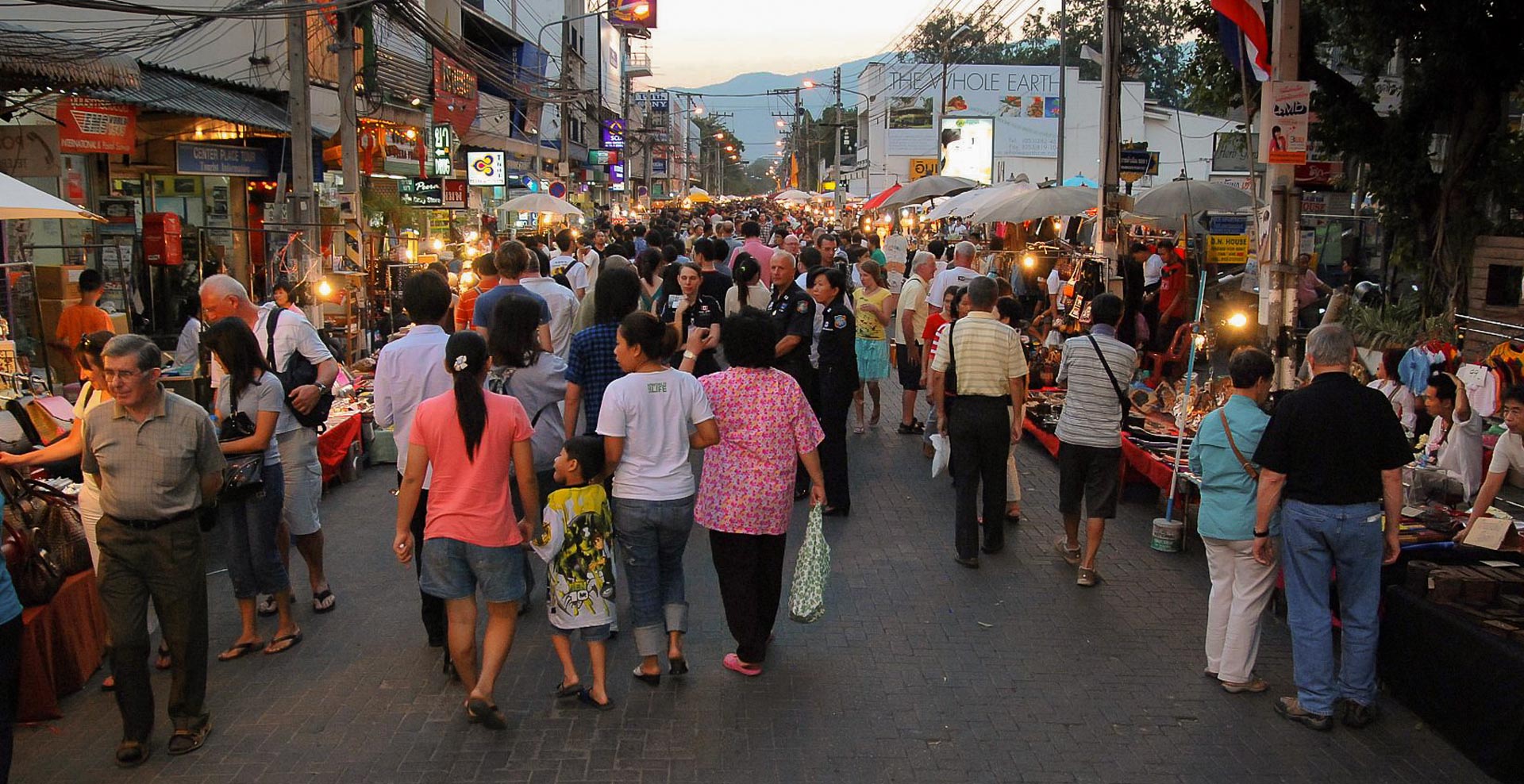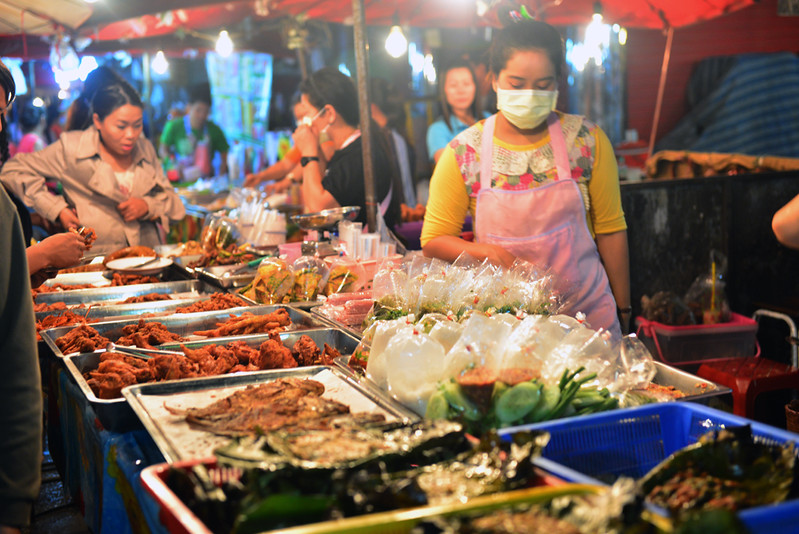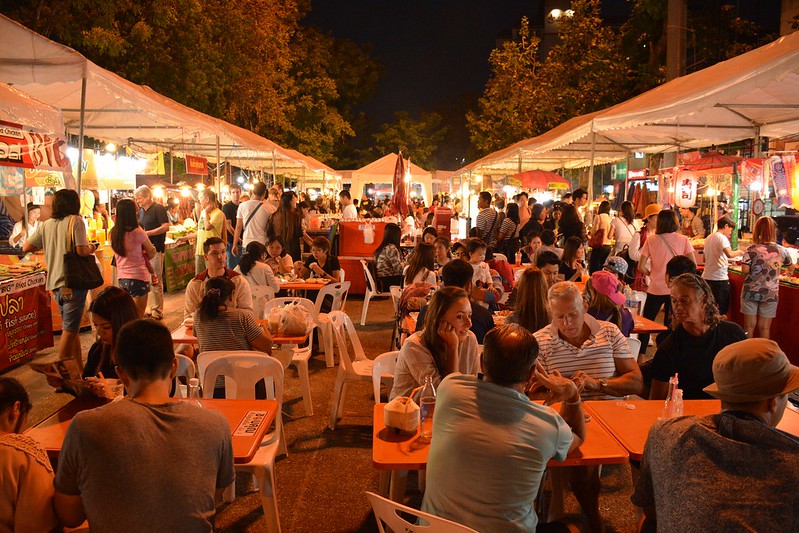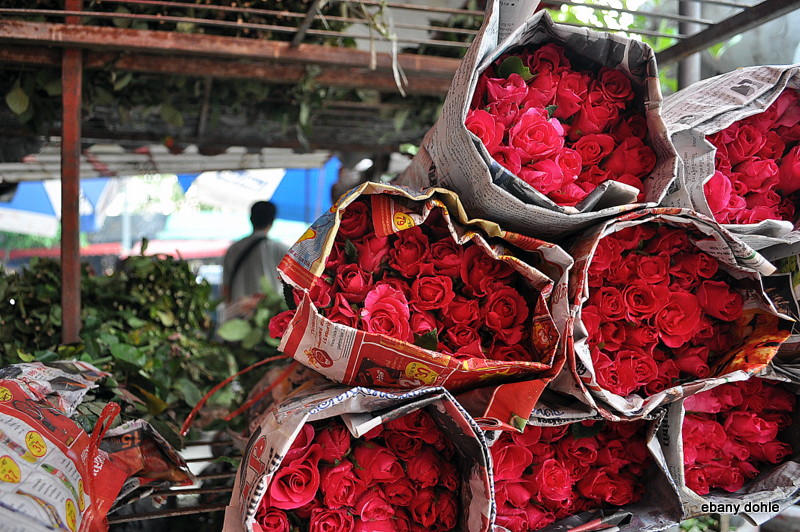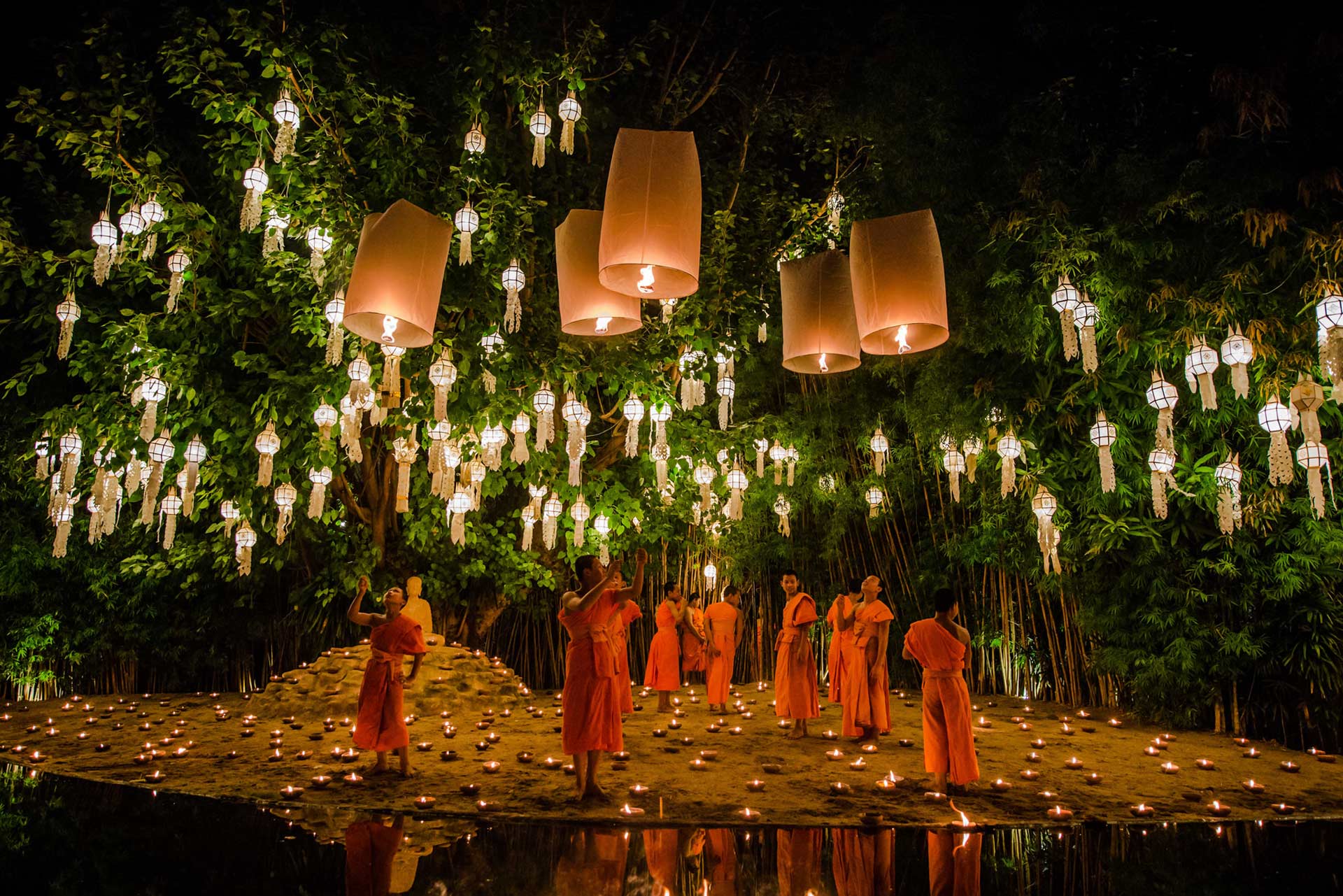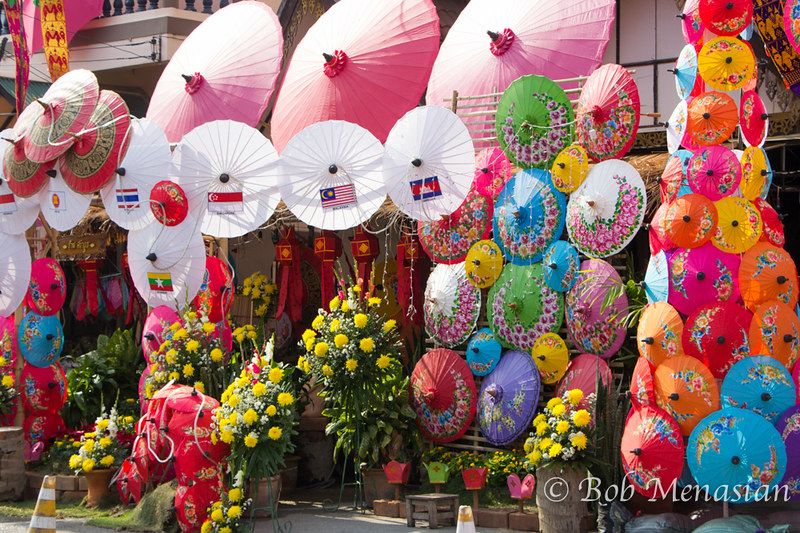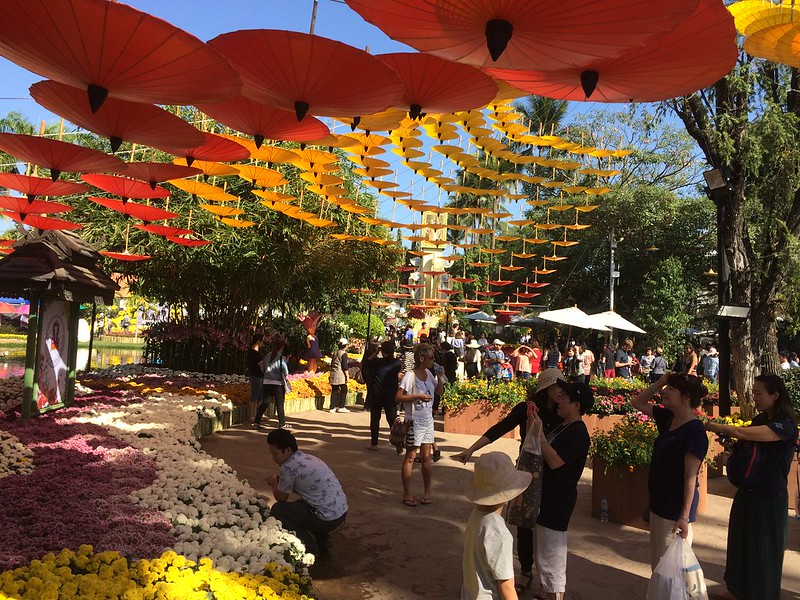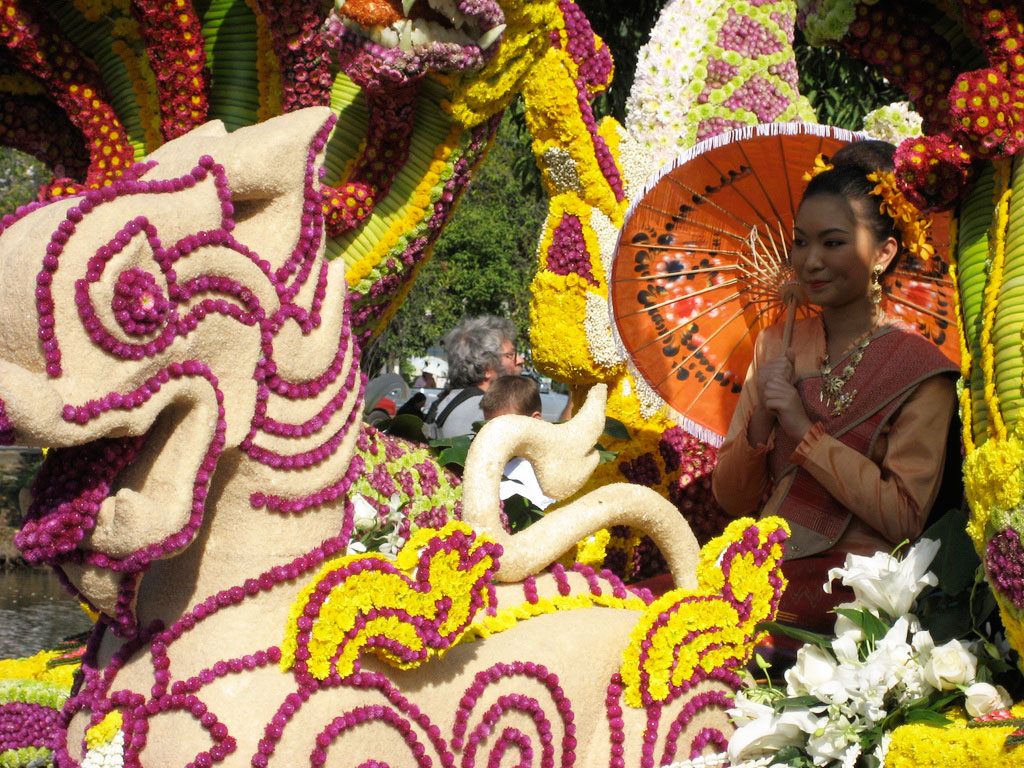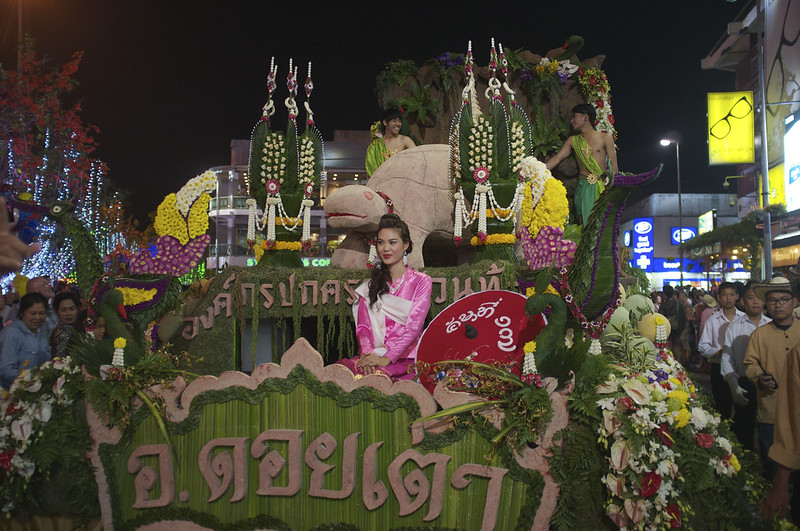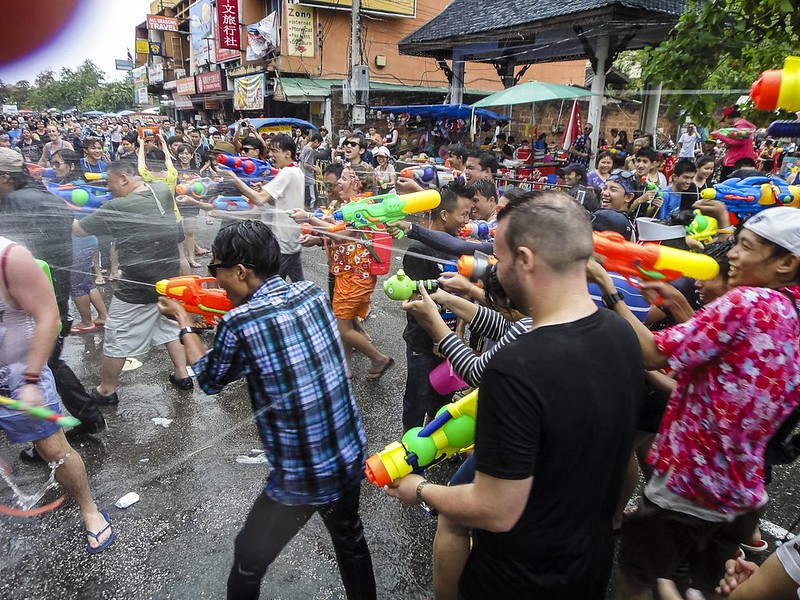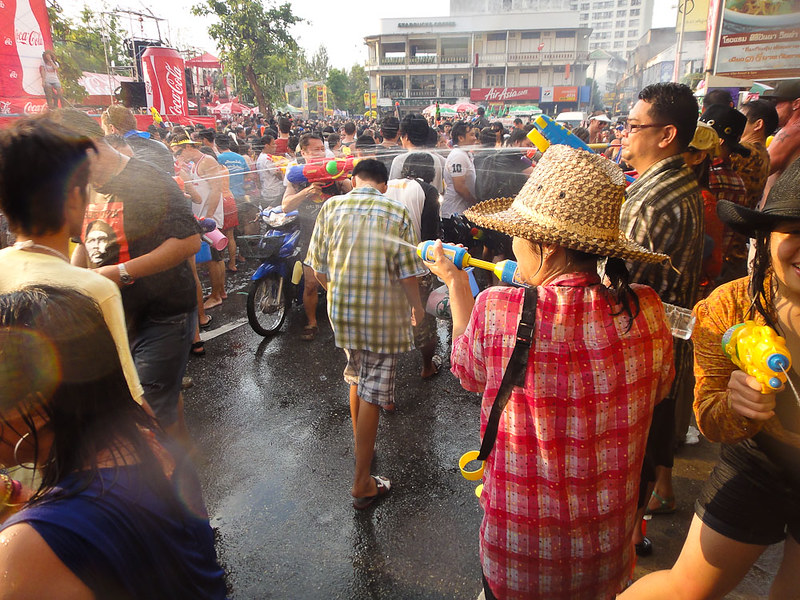Siem Reap for first-timers (What to Expect)
After the whole border situation entering Cambodia, we arrived in Siem Reap hesitant about the days to come. You can read the whole story here → Crossing the Infamous Poipet Border in Cambodia.
Siem Reap is a “small city” that rapidly grew and adapted to the massive tourist influx at the expense of the Angkor Temples. A river also called ‘Siem Reap’ divides the city in two. In the Royal Gardens, you can rest and escape from the afternoon heat under the old trees. Here’s where locals come to relax on the benches, socialize and play jianzi.
The sunlight has a magical deep orange hue and the city seems to be calmer around this area. There aren’t many people in sight, only a few local passerbyers, and businesses seem to be slow as most tourists are hiding from the heat or visiting the Angkor temples.
At the beginning and end of each day, an amusing anarchy in traffic starts. Cars, tuk-tuks, and minibusses packed with tourists come and go to the temples. Scooters and bicycles run wherever as fast as they can. Sidewalks are parking spots and pedestrians are forced to walk on the road — it’s every man for themselves.
Breathe in, breathe out
In Siem Reap, tuk-tuk drivers are next-level annoying. All they want is to take you on a tour of the temples or sell you some cocaine — both preferably. They’ll be parked on random streets, and outside every restaurant, hotel, and coffee shop waiting for tourists.
At the moment they see you asking for the bill in a restaurant, they’ll start touting. They will shout, whistle, clap, and hiss to get your attention. It’s intense. Breathe in, say ‘thank you’ and keep moving.
Tasting the gravy
Khmer food is amazing, and Cambodians are like wizards of pepper: amouk is great, Lok Lak even better. The spicy mango salads and the pork with pineapple are to die for.
Try all of the above with a fruit smoothie, any fruit smoothie.
We had the majority of our meals in a great restaurant called Moul Chheng Heang, near our hostel. The food was delicious and so were the prices, but what made us return every night, was the lovely enthusiastic lady running the restaurant.
She finished every sentence with:
– Yeah, yeah!
And lovingly made us promise we’ll return the next day.
– See you tomorrow. Ok?!
– Ok.
– Yeah, yeah!
Tip: The average street food costs 2,5USD. In restaurants near Pub Street meals start at 7 or 12USD. In most supermarkets, water is more expensive than in restaurants.
A dolla’ makes them holla’!
It’s weird to see an entire country on the other side of the world running on dollar bills.
Throughout Cambodia, you’ll need US dollars for everything: food, hotels, entrance fees, and transportation. They don’t care for their currency, so if you try to pay anything in Rhiels, they’ll roll their eyes at you.
Oh! And you better keep the dollar bills in pristine condition or they won’t take them.
The problem with the dollar bills is that everything got more expensive. There aren’t any nuances in prices and everything got rounded up to 1USD, 5USD, or 10USD.
Banks will give you dollar bills by default when you use any ATM, and the average fee is 4USD for each withdrawal.
A tip for European travelers: even though there’s a money-saving tip on Lonely Planet about Canadia Bank not charging any fees, it doesn’t work for European debit or credit cards.
Pub Street at night
Everyone comes here when the sun goes down: locals, backpackers, and tourists of all ages come to eat, drink and shop around. The street is filled with restaurants, massage parlors, coffee shops, and bars. And there’s always a happy hour somewhere.
Color is everywhere: in the neon lights of the bars, the tropical fruit in smoothie carts, the brightly lit bridges, and in the night markets on both sides of the river — Old market, Angkor market, and Night market.
Interacting with locals in Siem Reap
Unfortunately, every conversation that occurred was intended to make a sale and was definitely not in our best interest. As tourists, we got singled out and only treated as such. Locals couldn’t care less about your presence, so conversations never happened.
Siem Reap travel expenses (daily average for 1 person)
Water: 0.28€
Accommodation: 14.20€
Bicycle: 2.66€
Meals: 3,10€
Laundry: 0.87€ per kilo
If you have any questions or some extra info to share, please leave a reply. Thank you!
Crossing the Infamous Poipet Border in Cambodia
Advice on Cambodia Visas
If you’re considering crossing the border by land from Thailand to Cambodia through Poipet, we recommend getting an E-visa beforehand at www.evisa.gov.kh.
The e-Visa costs 35USD (5USD more than the visa on arrival) but it’ll save you from the stress and the “processing fees” charged on the land border. Better yet, if you want to cross the border smoothly, do it by plane as there are no scams in Cambodian airports.
What happened to us when crossing the land border to Cambodia was quite stressful. The infamous Poipet lived up to its reputation.
We woke up after a really bad sleep in Bangkok, to catch the 5:50 AM train to the border town of Aranyaprathet for a 7 hour trip through the central plains of Thailand. It’s a really pleasant trip that costs 48THB.
(By the way, if you’re looking for transportation from Thailand to Cambodia check www.bookaway.com. They have plenty of options at great prices, plus, if you use the code “gravy5″ at checkout you’ll get 5% off your ticket price).
We started with a plan
It’s important to say that every plan or decision we make comes from what we’ve learned from travel books, blogs, the experiences of other travelers, and a little dash of intuition of our own. We do our homework pretty well. Studying and preparing ourselves with a good itinerary and a plan.
The plan for the day was to get off the train in Aranyaprathet, get a tuk-tuk to the Thai border for 80THB, get a stamp from Thailand to get out and a stamp from Cambodia to get in. Simple.
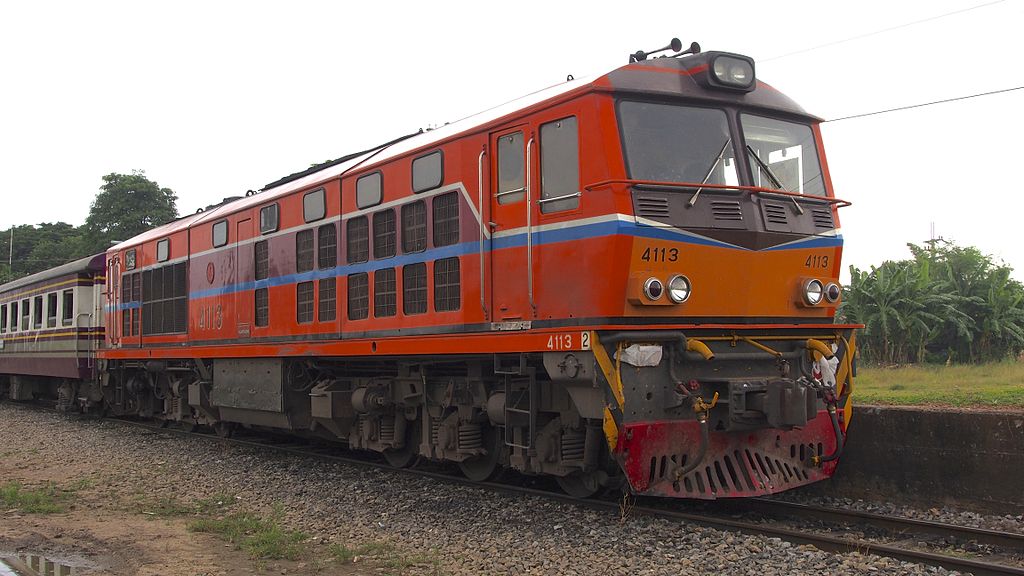
Clay Gilliland
The tuk-tuk cost us 200THB for a 10-minute ride. Fortunately, we ended up sharing the tuk-tuk with two American backpackers: Ryan and Winslow, that we had the pleasure to get to know along the ride.
At the Thai border (Aranyaprathet)
As soon as we got to the Thai border, we started walking to the building along with many other tourists and backpackers. There was a local market around, lots of tuk-tuk drivers and other random men. We immediately followed Winslow — the seasoned traveler from New York, coming to Cambodia for the second time.
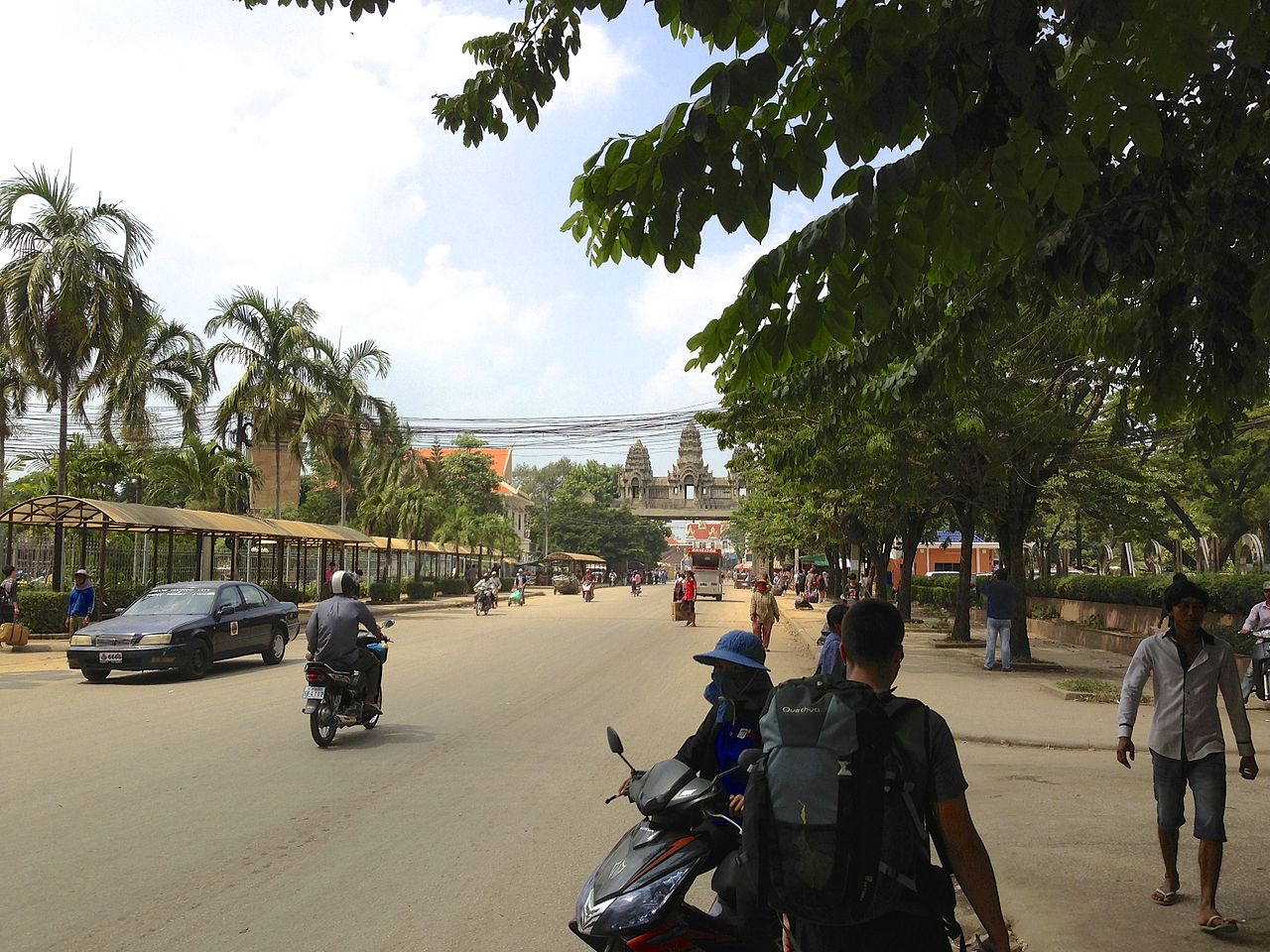
Clay Gilliland
Inside the building at the foreigners’ queue, we filled the departure card, handed over our passports, got a photo taken and our passports stamped. Super easy!
Went down some stairs and entered no man’s land and a bridge over stagnated water. At the end of the bridge, some dodgy men in hats were allegedly selling illegal visas, but none of them approached us. We just kept walking to the right end of the bridge into the Cambodian border offices.
The welcoming party at the Cambodian Border (Poipet)
As soon as we got in, a government official gave us a form to fill in.
We filled the form and prepared a photo, our passports, and the 35USD each (just as it said in every textbook, travel site, and in the big sign above the office counter). As we tried to hand them to the border officials behind the counter, they refused to take them, pointing to a handwritten sheet of paper that said “35USD + 100THB”.
So there we were in front of border corrupt government officials, trying to extort some extra money from tourists crossing the border. Just exactly as every textbook, travel site, and Winslow warned us. Great…
A little intimidated Nuno and I (plus all the riled-up backpackers in the queue) refused to pay the processing fees, which only made the officials speak louder in Khmer and point extra hard to the “100THB” in the paper.
The waiting game
Seeing that we weren’t going to give in, they took us aside, made us sit on some plastic chairs, and ignored us.
By then everyone is annoyed, anxious, and tired from the long train ride. After what felt like forever, a cranky officer came and took our passports and forms.
20 minutes later he came back, yelling our names and handing out our passports and visas. We got out of there as fast as we could.
Still trying to process what had happened, another officer took us to another long queue. This was the queue to get our visas stamped. Now, unfortunately, there was a power outage and no power means no processing tourist visas. So we had to wait. Under a boiling metal roof.
After 20 minutes, the power finally came on. Once again, we gave our passports to the officer, he took a webcam photo, moaned something, stamped the passports and we got in.
Siem Reap off!
After this whole border mess, we just wanted to get to the next bus to Siem Reap.
From what we’ve read, the bus station was nearby and the bus would prevent us to get ripped off by taxi drivers that wait for tourists at the Poipet border roundabout.
Ryan, the backpacker we met at Aranyaprathet asked Winslow, Nuno, and I to share a taxi. Our minds were still fuzzy from the heat and the border stuff, so we said yes!
We just wanted to calm down, and rest.
The taxi ride was 2h30 and cost us 48USD. Quite expensive considering it was not a taxi at all. Just a dude in a car, moving people from here to there in his spare time.
At least he had air-con and promised to leave us at our hostels.
Arriving at Seam Reap, the driver turned in a random street, pulled over, and told us to get out. We had no idea where we were, and outside the car, a group of Cambodian men were already taking our backpacks from the trunk. Something wasn’t right. And it the second time that day we felt like shitting our pants.
Winslow was the first to get out of the car and started yelling at the driver. Things got pretty heated and the Cambodian men started surrounding Winslow and us.
Basically, it was all a scam:
The fake taxi driver overcharges tourists at the border and dumps them in that corner of Siem Reap where other tuk-tuk drivers await. The tuk-tuk drivers will then take the tourists to their hotels – for more money obviously – and ideally get booked to show them the Angkor temples for the next days.
Winslow refused to pay the taxy driver and refused to go on any tuk-tuk, screaming and threatening to call the police. By now the tuk-tuk drivers were also yelling, laughing, and making fun of him, which only made things worst.
What the f*ck have we got ourselves into?
Shit was about to go down when the taxi driver, backed down from the argument and said he’d take us to our hostels. As soon as we saw the famous Pub Street, we got off the car and figured the rest out.
Not a good first impression of Cambodia.
It was quite a rough day but hey, it’s all gravy!
All transportation from Bangkok to Chiang Mai
There are several transportation options to travel from Bangkok to Chiang Mai. Below, you’ll find a set of alternatives to do so along with costs, timetables, and trip durations so you can decide which works best for you.
Buses from Bangkok to Chiang Mai
Bus trips to Chiang Mai take 10 to 12 hours.
You can book your trip online on www.bookaway.com (use the code “gravy5″ at checkout to get 5% off the ticket price), at one of the many travel agencies in town (preferably near your hotel), or at Mo Chit Bus Terminal.
Tourist Buses
Tourist bus tickets fees to Chiang Mai start at 530 THB.
Most buses depart from Khao San Road every hour. If you opt for the overnight bus and need to put a backpack on the luggage hold underneath, make sure to carry your valuables with you on the bus.
Deluxe Buses
Deluxe bus tickets fees can go up to 850 THB.
All deluxe buses heading to Chiang Mai depart from Mo Chit Bus Terminal (easily accessible via Skytrain).
You can buy your ticket for that day once you arrive at the station. There are complimentary snacks and water for the road.
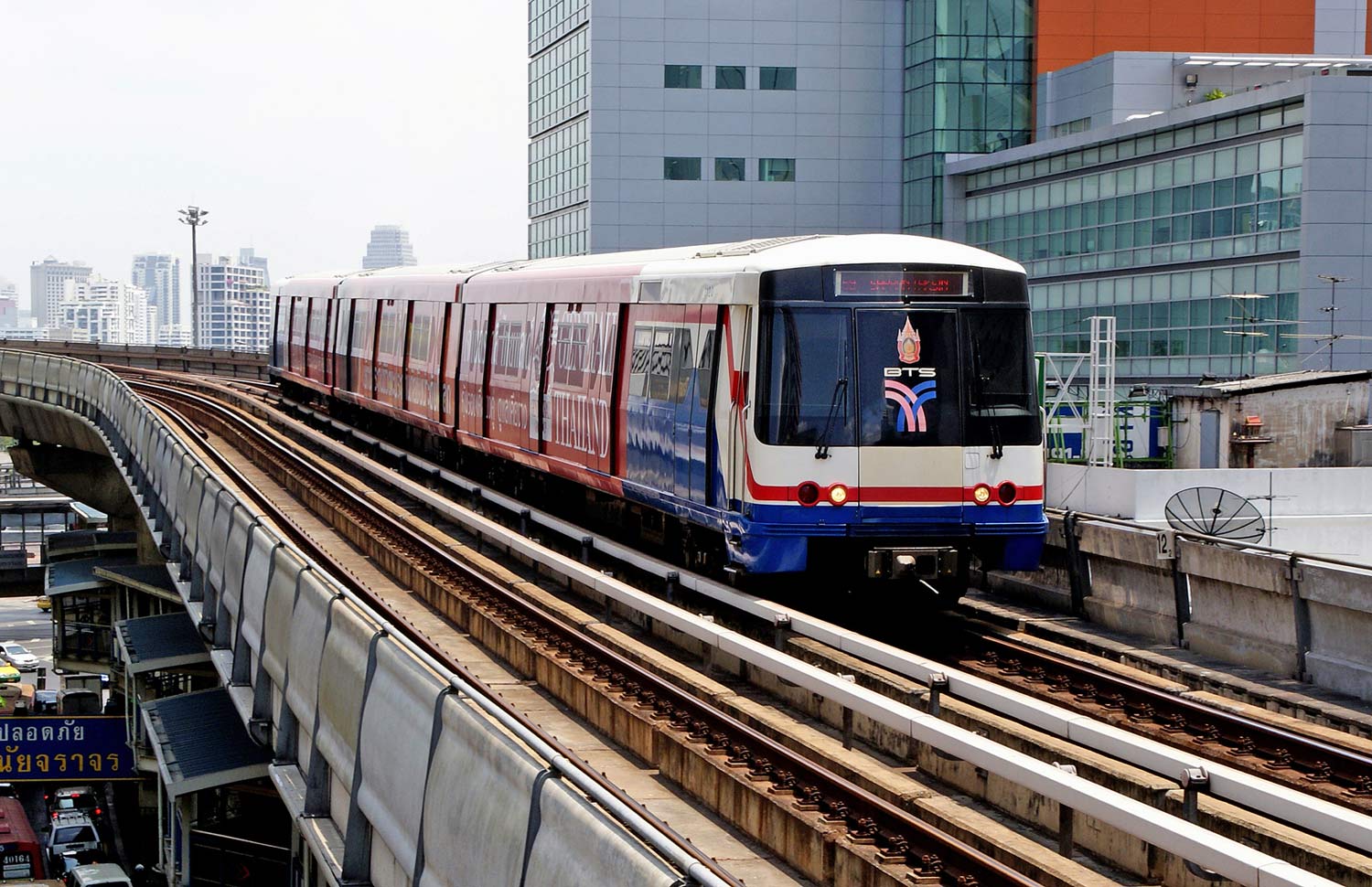
Bangkok Skytrain BTS
How to get from Chiang Mai Bus Station to the city center
In case you decide to go by bus, you should know that Chiang Mai has two bus stations: Arcade Bus Station and Chang Puak Bus Station.
The Arcade Bus Station is located at Kaeo Narawat Road. Terminals 2 and 3 are where all the long-distance buses coming from outside the Chiang Mai province arrive and depart (Bangkok, Chiang Rai, Phitsanulok, Ubon, Korat, Nan, Luang Prabang, Mae Sot).
From the Arcade Bus Station, you can quickly arrange a songthaew to take you to the city (Tha Phae Gate). The songthaews fare is 100 THB, but if you’re willing to wait for the songthaew to fill up, you can lower the price to THB 20 per person (expect to pay more if you want them to take you to the hotel). The trip takes around 15 minutes.
Choosing the Airplane
Chiang Mai International Airport receives domestic and international flights. Daily flights are coming in from Bangkok at almost every hour.
The low-cost airlines operating at this airport are:
• Air Asia
• Nokair
• Thai Smile
• Vietjet
Plane tickets from Bangkok to Chiang Mai start at 1000 up to 3400 THB, and flights take an average of 1h20m.
You can book your flight over on bookaway.com (and use the code “gravy5″ at checkout to get 5% off the ticket price).
From the Airport to Chiang Mai:
Taxis are waiting at the northern end of the airport, and trips to the city center should cost around 160 THB.
In the southern end, you’ll find the Airport shuttle buses (not very frequent) charging 60 THB, and songthaews charging 40 THB. Both only tend to leave when they’re full.
Tip: If you’re willing to walk a few hundred meters on the main road outside the airport, you’ll be able to get a songthaew for 20-25 THB.
Choosing the Train
You can travel from Bangkok to Chiang Mai by train during the day or at night. Check the timetables here: www.railway.co.th
Trips can take 14 to 16 hours, therefore, to optimize your time, you can travel at night on a sleeping train. As this is a very sought after option, buy your tickets in advance, and to avoid commissions, avoid travel agencies and buy the ticket at the Station counter yourself. Now, if you prefer buying your train tickets online, we recommend www.bookaway.com (you can use the code “gravy5″ at checkout to get 5% off the ticket price).
Have in mind that Chiang Mai train station is located 3 km from the city center, but there will be songthaews at hand on the train station.
If you have any questions or some extra info to add, let us know in the comments.
Easy guide to Sapa mountain trekking
As soon as you set foot on Sapa, you’ll be bombarded on all sides by trekking opportunities. So there’s no need to book a trek in advance because resources abound.
In this guide, we will delve into the whole Sapa trekking tour process:
• How to book it
• Treks to choose from
• Prices
• Equipment
• Our experience at it
Booking a trek in person or by phone
Two months before arriving in Sapa, we were recommended a local guide by a Portuguese backpacker we met in Kampot. We followed her suggestion and called Mama Mae — the local Hmong guide she told us about.
The booking process was simple: you can do it directly with the local guides as they approach you in the street, or by phone since they’ll hand out their numbers if you’re not ready to commit on the spot. You can also do it through your hotel, the Sapa tourism office or any tour operator around town.
You can book one of the following options:
• Half day trek
• Full day trek: includes one meal
• 2-day trek with homestay: includes two meals and a few drinks, a bath, and a bed for the night (usually at the guide’s family house)
• Some tour operators like Buffalo Tours or Sapa Sisters offer up to 5-day trek options
Then you’ll set up the day, time and spot where the trek starts.
The payment is usually done at the end of the trek.
Price tables
Booking directly through a local guide will cost a fraction of what you’ll pay to a tour operator. Still, every guide has her own fee and these are some of the offers we got:
Mama Bau: 14€ for one day trek and 28€ for 2 days + homestay.
Mama Susu: 11,50€ for one day and 28€ for the 2 days + homestay.
Mama Mae: 11€ for one full day
Tour operator fees start at 35€ for one day
If you’re an experienced hiker you could do the trek on your own, but by hiring an experienced guide you’ll be helping the local communities and learning about them. Besides, no one knows the hillside as they do.
Let’s do this!
Nuno and I met Mama Mae at 9 in the morning, near the Gothic church in the city center. The two of us joined a group of four American girls and three other Hmong women that walked alongside us the entire trek.
Mama Mae spoke very good English but the other Hmong women did not. We figured that they must accompany tourists as a way to practice their English, so eventually, they can become guides themselves.
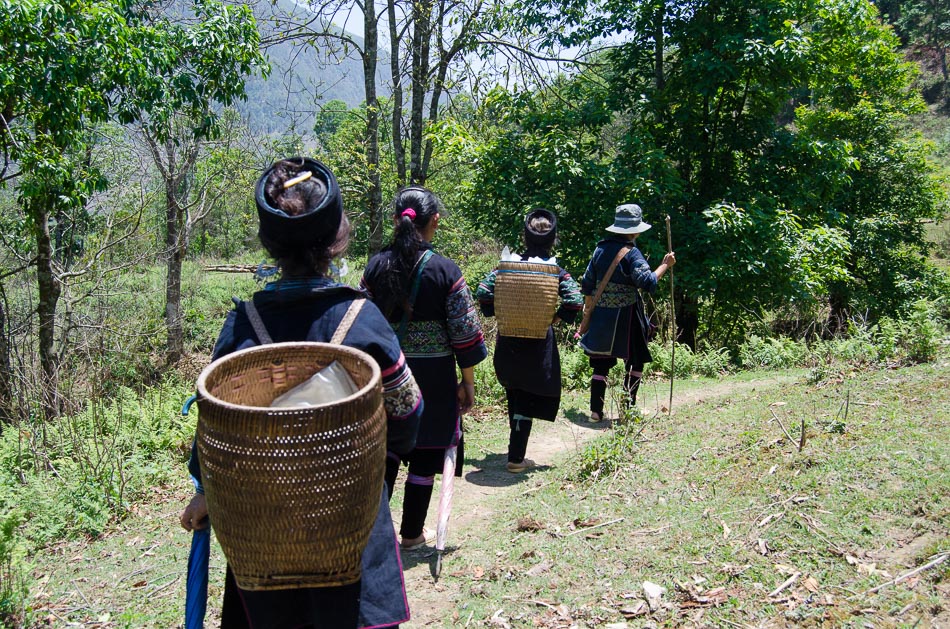
Take plenty of water
It was a beautiful warm and sunny day in opposition to the stormy days before. We were super excited to be out and about exploring nature, and having a genuine taste of the Vietnamese rural life.
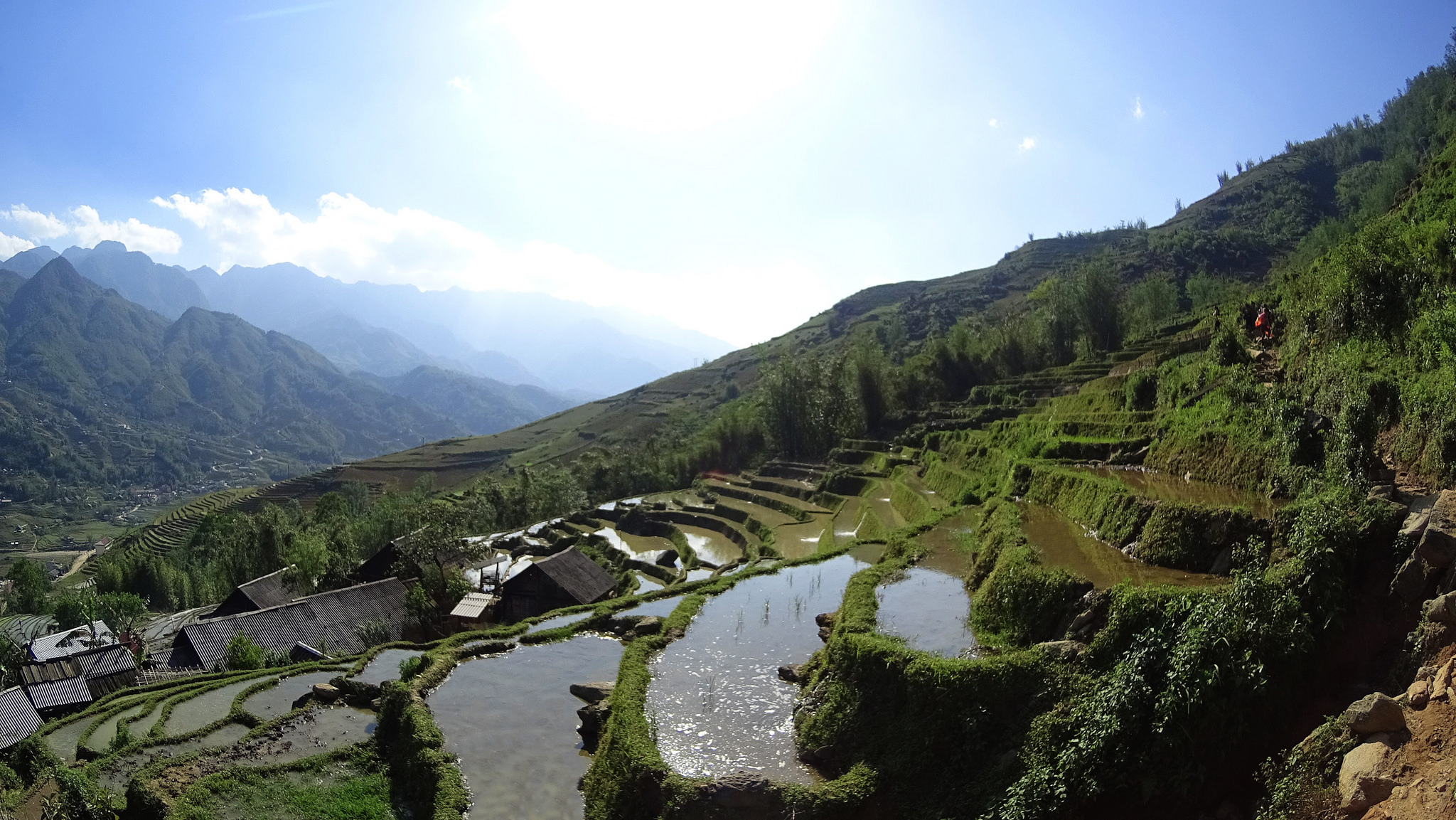
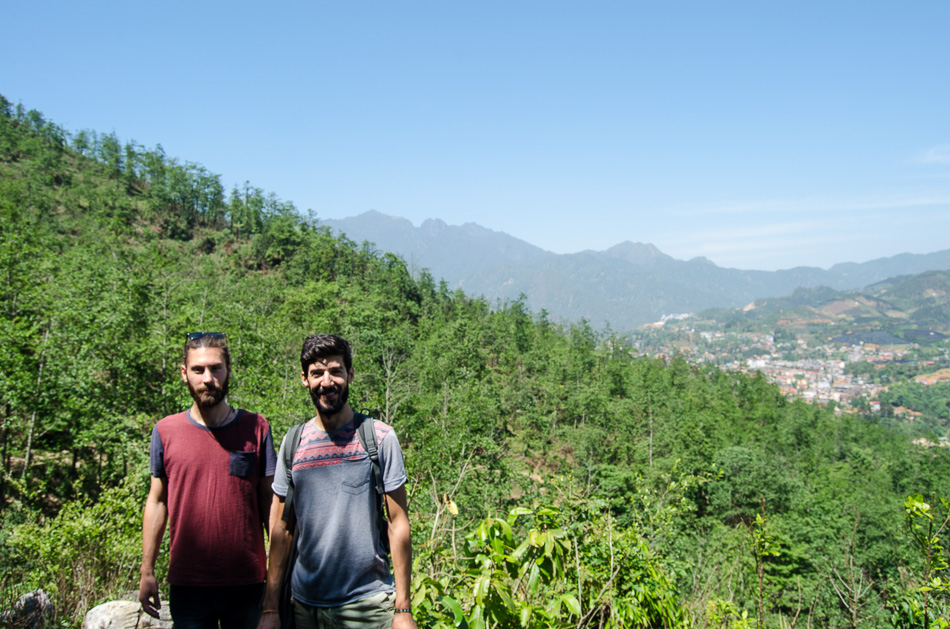
However, two hours in, we realized that 1,5L water bottle wouldn’t last long for two grown men hiking a mountain and descending through muddy rice terraces. Not to mention that Mama Mae got thirsty too, so we ended up sharing our water with her—because we’re gentlemen.
Take plenty of water, you’ll need it. There aren’t any shops in the hills, only in the villages.

Soul cleansing views
The scenery was breathtaking—everywhere we looked was like a panoramic screensaver!
Not only Mama Mae took us to the best lookout spots in the mountains, but we also saw water buffaloes, piglets, tea and cannabis plantations. We talked for hours about Vietnam, her family and ours. She was like an open book.
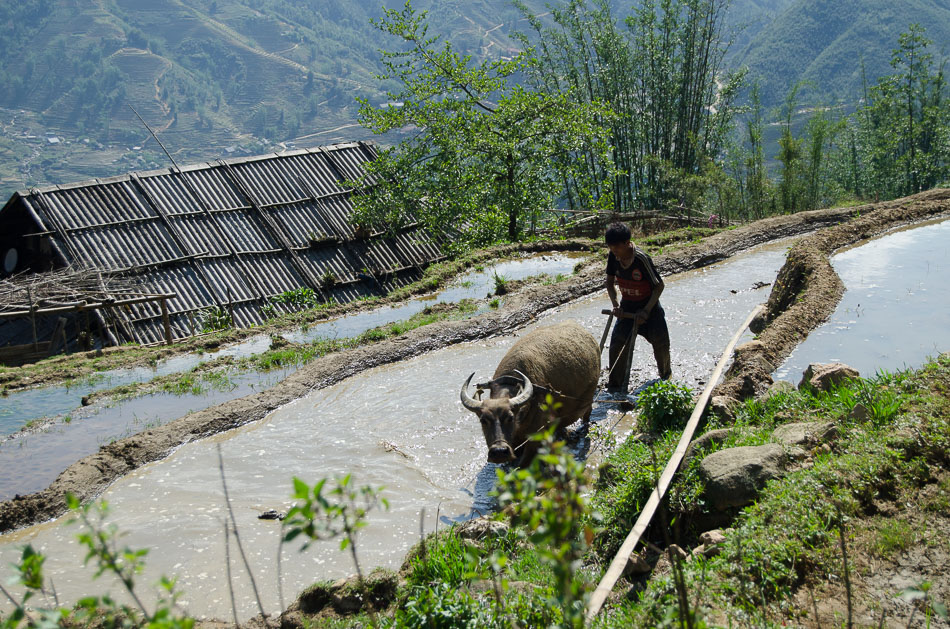
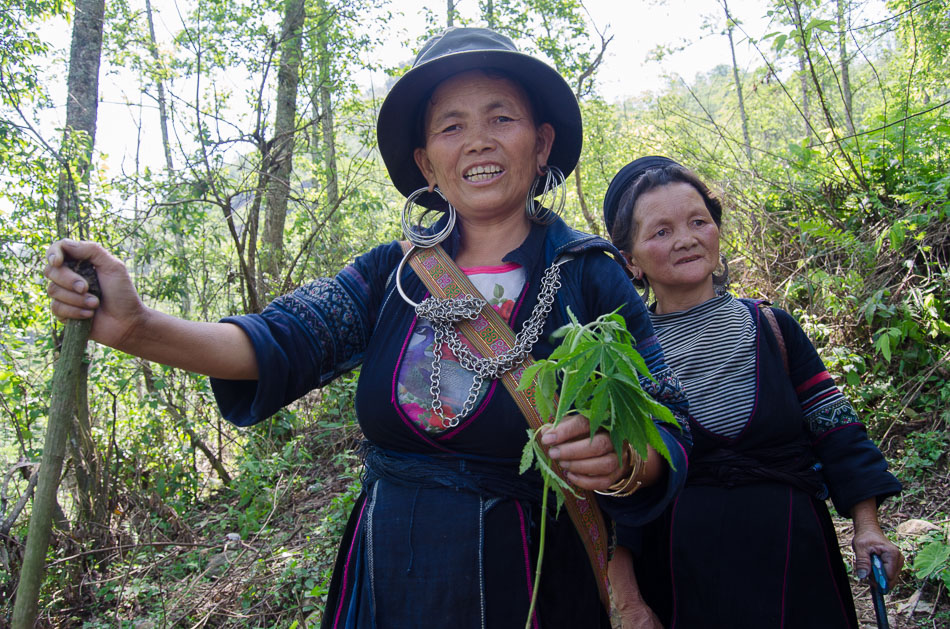
Meanwhile, the other 3 Hmong women kept walking by our side asking time and again:
– Where are you from?
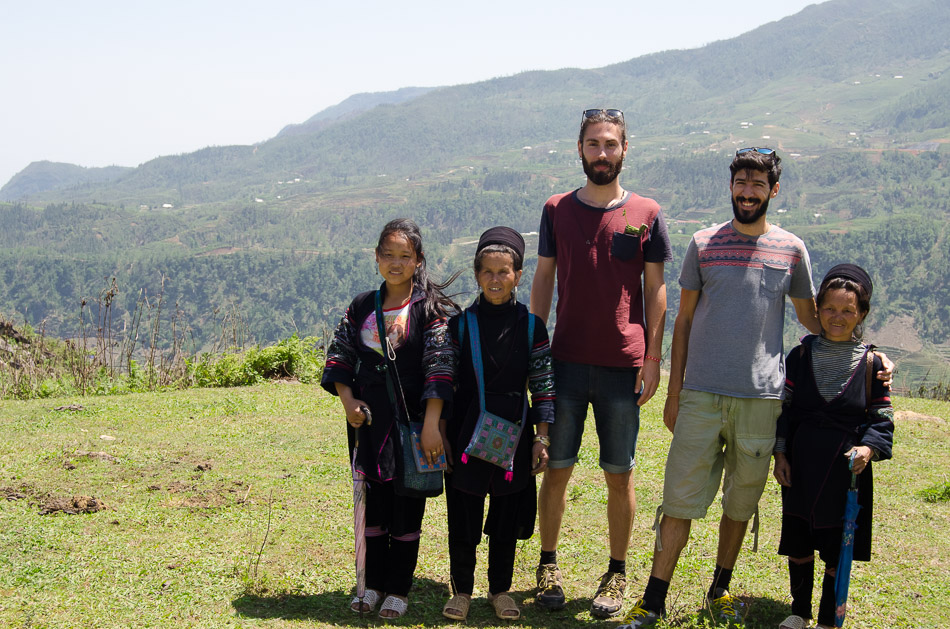
At noon, we stopped for lunch at a humble restaurant where other hikers were. Mama Mae provided us with a noodle soup and some pieces of fruit, but the drinks we paid ourselves. After lunch, we walked a few more hours to her house, where the first day of trekking ended. We met the husband and granddaughters as she prepared some tea for us: Lipton, believe it or not.
After tea, she explained how she makes indigo blue dye from plants.
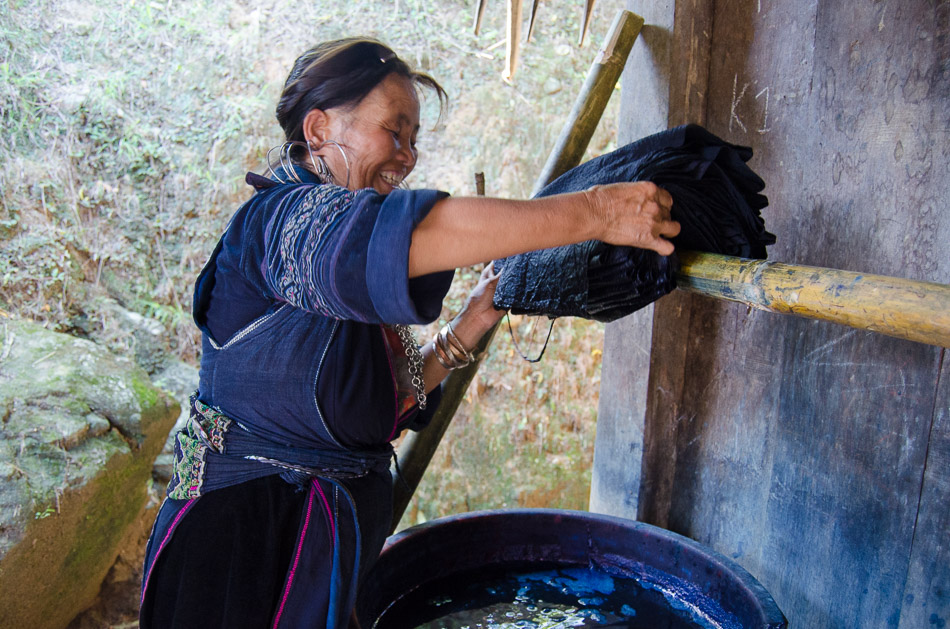
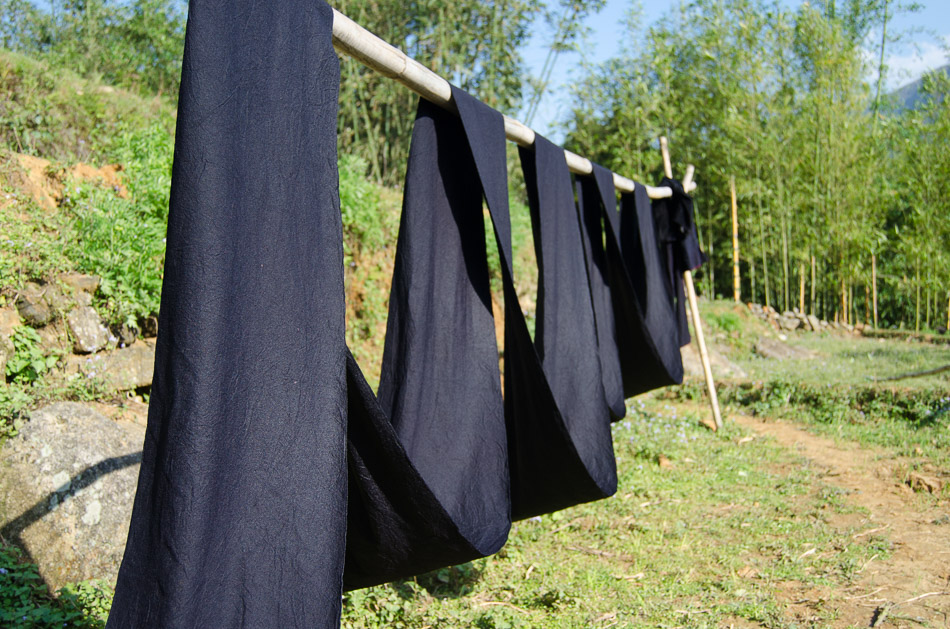
True colors
The other 3 Hmong women that followed us around came with a goal in mind: to sell. To sell as much as possible.
After a subtle sign from Mama Mae, they pulled out all sorts of knick-knacks from their wicker baskets: bracelets, wallets, shawls, and whistles, along with an aggressive selling tactic. They turned into unfazed vending machines that didn’t take “no” for an answer.
Back to Sapa on a motorbike
Having finished our full day trek, Mama Mae took us to the center of her village, calling two motorbike taxis to take us back to Sapa: 2.00€ each, paid by ourselves.
The ride back to Sapa alone was amazing. It’s not every day that someone can ride through valleys in Vietnam, with the sun setting behind the mountains and the last sunbeams reflecting on the rice paddies. That’s something we’ll never forget.
Trekking equipment
Keep it light and simple.
All you’ll need is a comfortable pair of sturdy shoes, light clothing, and a camera. Remember to take plenty of water, snacks, sunblock and you’ll be good to go.
As a side note, Sapa has plenty of shops that both rent and sell trekking gear.
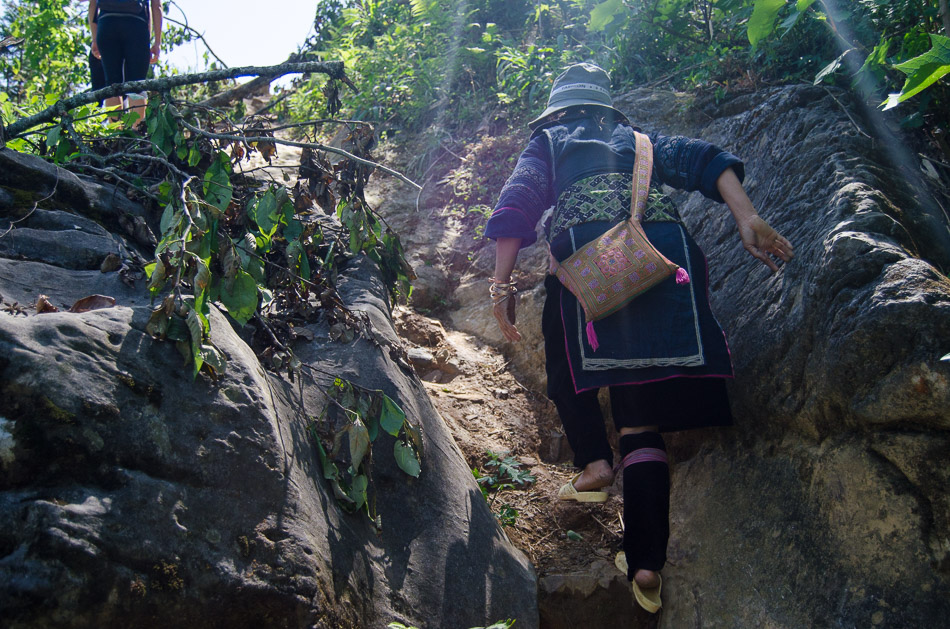
Full day trek expenses
Full day trek: 11€
Motorbike taxi: 2€
Water bottle: 0.60€
If you’re planning a trekking tour on Sapa we still have Mama Mae’s, Mama Bau’s and Mama Susu’s phone numbers and will gladly share them with you. Leave a reply down here or at any of our social media outlets and we’ll send it to you via email or PM.
Here’s a photo of Mama Mae taken in September 2018 by Cristelle — one of our readers. Cristelle reached out to us and asked for Mama Mae’s phone number. Two days later she was trekking with her in Sapa!
We’re super glad to contribute (even if in a small way) to your adventures, and by doing so helping Mama Mae on the other side of the world.
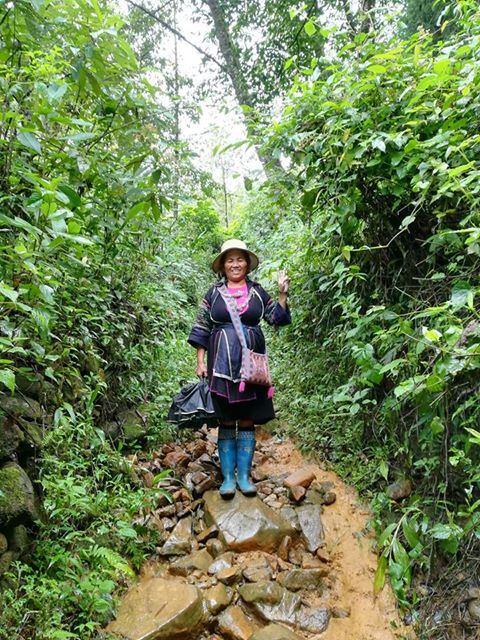
Mui Ne and the Police
After more than 5 hours on a bus, we arrived in Mui Ne at dinner time. The bus company we traveled on (Futa), conveniently dropped everybody at their accommodations—don’t know if it’s company policy or because all hotels are on that main road.
It was weird to travel on a sleeping bus during the day, luckily the WiFi worked just fine.
Looking for transportation to Mui Ne? Check out www.bookaway.com.
To get 5% off the ticket price use the code “gravy5″ at checkout.
As soon as we got our room at the 247 a/c Guesthouse we dropped the backpack on the floor and headed out to hunt for some dinner. Starving and not being fans of seafood, we needed some alternatives.
As we walked along Mui Ne’s main road a nice Vietnamese lady selling kitesurf packages and boat excursions invited us to see her menu. We were hungry and the photos on the menu looked good, so we said ‘yes’.
Let’s just say that we learned something that night: travel agencies are not restaurants.
Two days later we found an open-air food court named Dong Vui Square. A really cool place with a great selection of foods: from noodles to paella.
Mui Ne Beach
The next morning, after a bowl of fruit and muesli—which reminded us of our breakfasts in Ayutthaya—we went off to the beach. Or tried to at least.
From the terrace where we had breakfast, we could see the water peeking from between the houses. Even though it was right there in front of us, reaching it was a pain in the ass. Here’s why: along that main road we mentioned before, all sorts of buildings and private properties form a barrier between people and the beach.
To reach it we had to trespass private property, and like Bonnie & Clyde, we did. Later that day we found a “legal” crossing near the local market.
Mui Ne is a fishing village and the small round boats that look like plastic kiddie pools anchored in the open sea prove it.
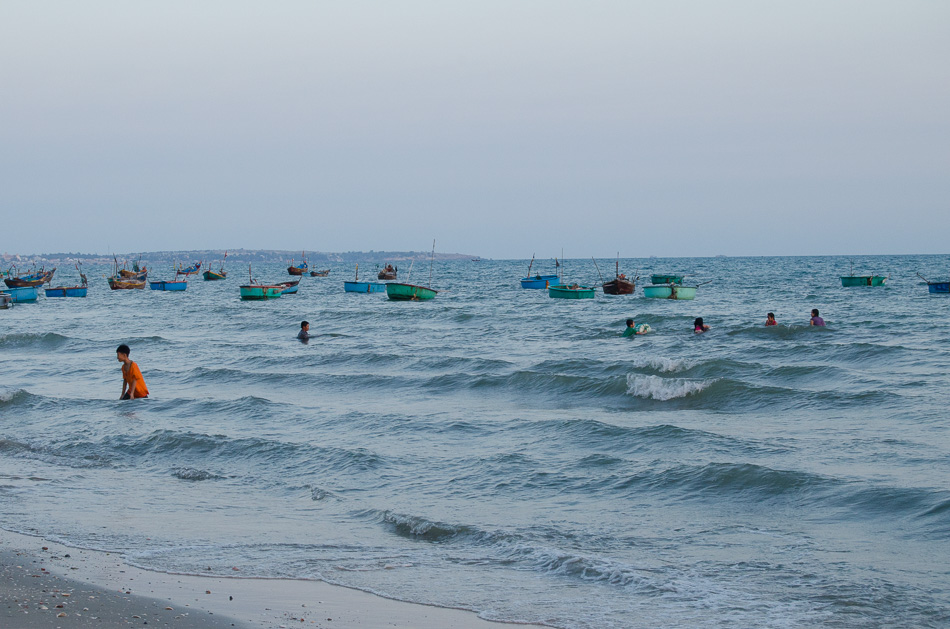
The coastal strip of sand stretches for several kilometers and is lined with tall coconut trees. The water is blue and the sun shines all year round. The beach has the potential to be in any travel catalog if it wasn’t for all the garbage scattered everywhere. So after a chat in the sand, we left.
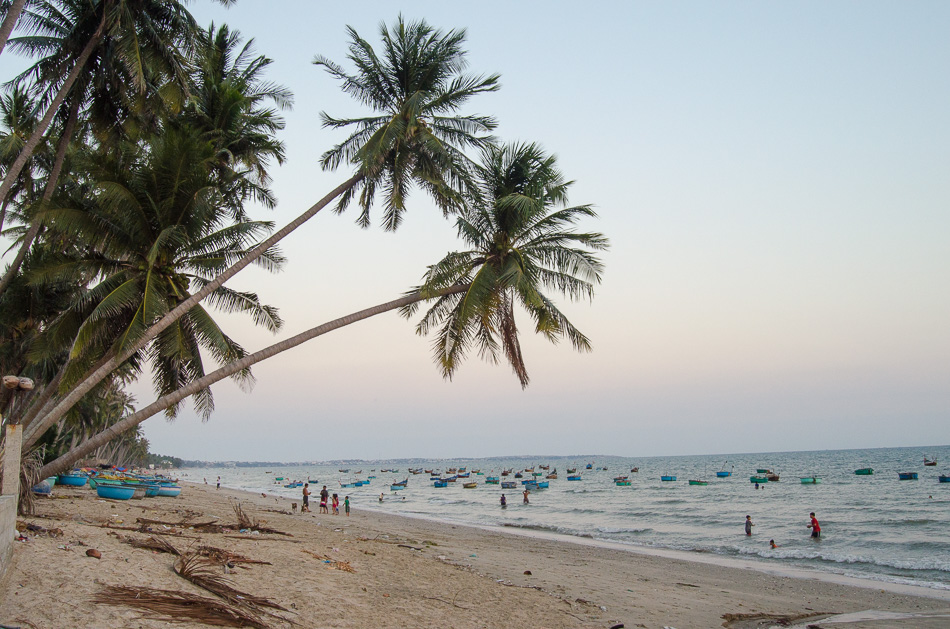
To explore more of Mui Ne, we rented a scooter.
The more west we got, the cleaner the beaches and the ocean.
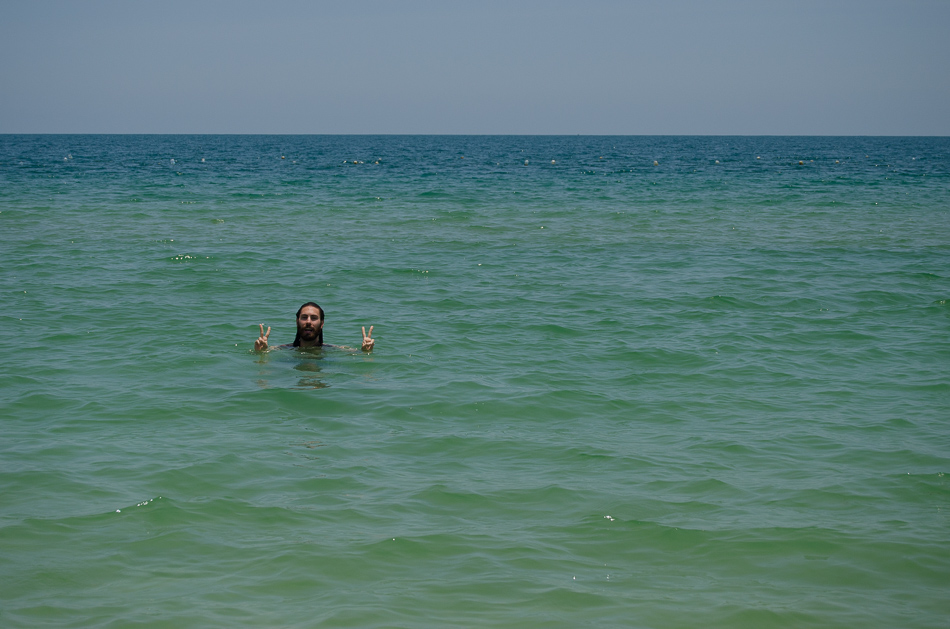
Learning to ride bikes in Kampot and understanding the convenience of driving, gave us the audacity to think that ‘from now on scooters are the way to go‘. So we rented one directly from our guesthouse for 80,000 Dongs (€ 3,20) for a whole day.
We rode to the actual fishing village of Mui Ne that appeared to have more boats than people. Unfortunately, besides a beautiful view from the high points, there’s not much to do around here. We stopped for lunch and took some photos.
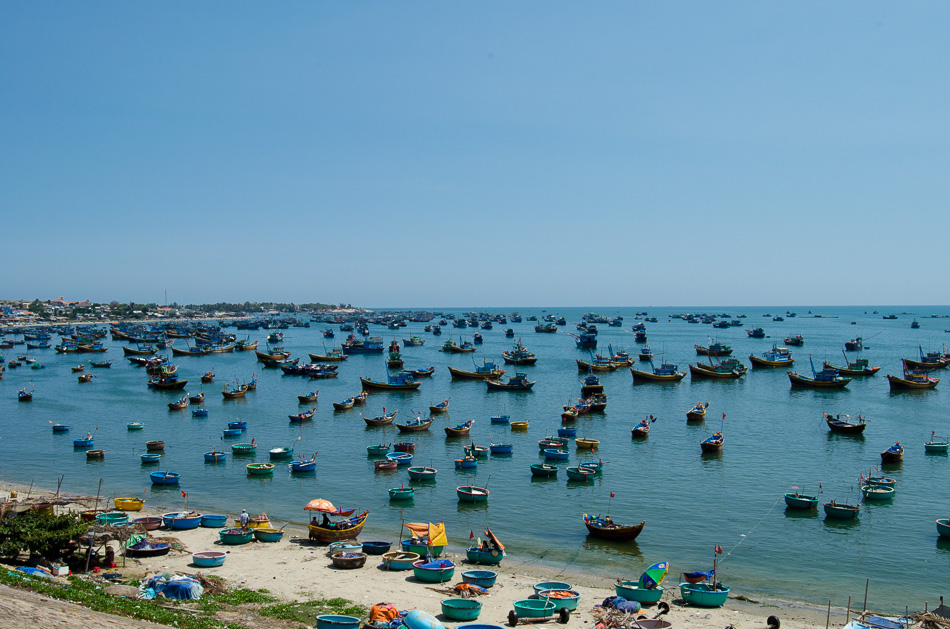
Running on the floor of the restaurant was a big rat looking for food, completely unfazed by humans—we named it Bertha.
Bertha looked strong and healthy, so the food had to be good.
Problems with the po-po
After lunch, we hopped on the bike and headed towards the White Sand Dunes of Mui Ne. Halfway through, two police officers pulled us over.
A very friendly officer holding a booklet approached us and asked for our international driver’s license, which we didn’t have. However, we anxiously flaunted our regular Portuguese ones, but by now, we knew we were in trouble.
He looked at us, frowned condescendingly, and flipped through the booklet showing us a bunch of gore illustrative images of what can happen to tourists driving without an international driver’s license. His portfolio included:
• Amputee tourist
• Tourist blood
• Reckless tourist speeding
• Tourist in a wheelchair
• Drunk tourist getting drunker planning to drive afterward
• A WordArt clock representing the short life of tourists that drive outside their country
Finally, he pointed to the page where the traffic fines were. According to him, it said we had to pay 1,200,000 Dongs or he would have to arrest us.
We didn’t have that amount of money, so he flipped the page again to a clause saying we had to pay 800,000 Dongs—which we didn’t have either.
Nuno and I were frantically searching for money in our wallets, pockets, and backpack. All we managed to put together was 300,000 Dongs and a pre-diarrhea feeling.
Seeing how upset we were, he grabbed the money from our hands, smiled, and said:
– Shhh. Ok, ok. I am your friend… You can go now. No more police ahead.
That was the moment we realized what had happened: we got scammed by a police officer. How nice!
We turned around and headed back to our guesthouse.
Getting over it
After doing the conversion from Dongs to Euros we realized that he ‘confiscated’ just €12, but it could have been much more.
To take our minds off what had happened, we went hiking in the Fairy Stream near the Mui Ne main road—as you may have noticed, almost everything extends along this road.
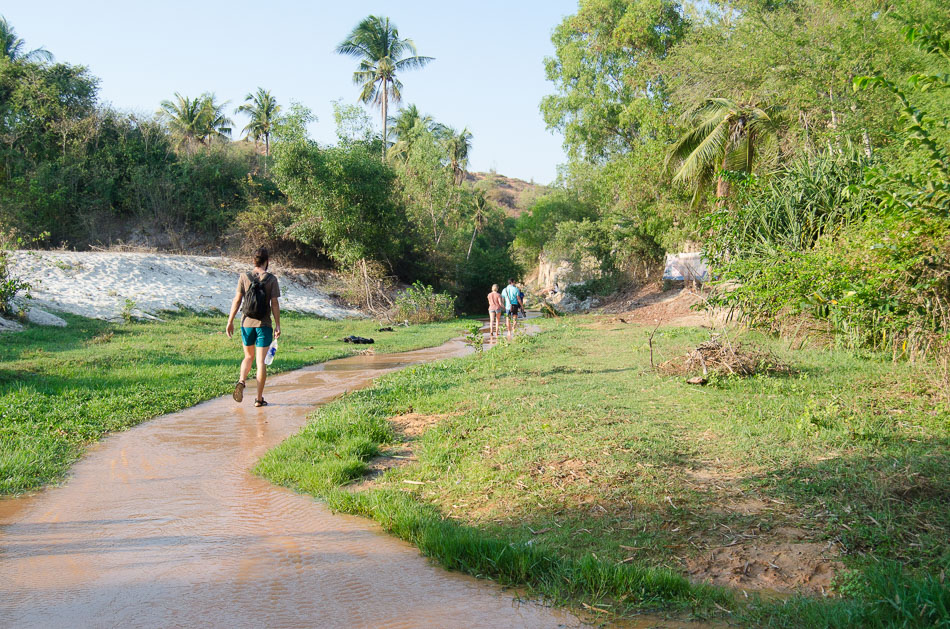
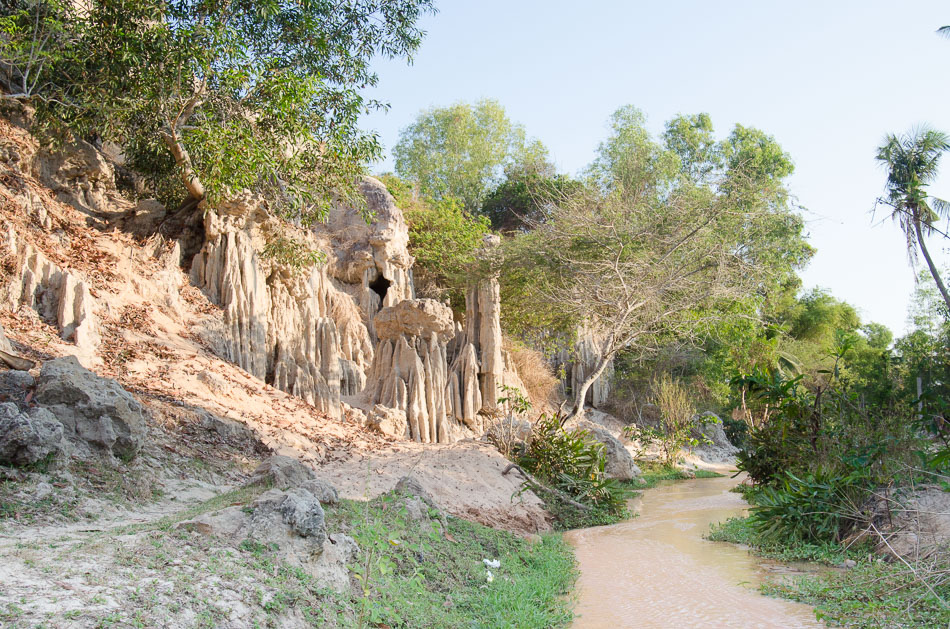
It is a small stream of freshwater where you can walk on and enjoy the surroundings. There are red dunes, rock formations, trees, ducks, and cows walking around.
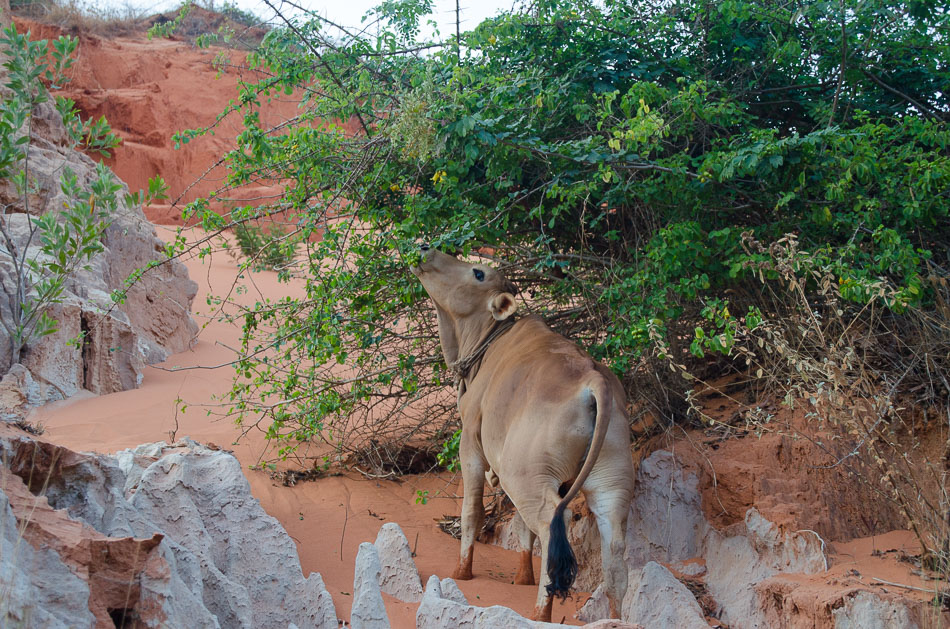
There’s no entrance fee around here, but rumor has it that some crafty locals might try to charge you for it. Also, if you get there by bike you will be charged for parking. To avoid it, park further from the entrance and walk there.
As a maritime zone, Mui Ne is slowly attracting upscale tourists to all the fancy resorts by the sea. It might not have much to explore, but it offers you good weather and a relaxed environment. Especially if you don’t find any police.
Mui Ne travel expenses (Daily average for 1 person)
Breakfast: € 1,85
Lunch: € 1,64
Dinner: € 3,31
Water: € 0,19
Coffee: € 0,57
Accommodation: € 3,50
Scooter: € 3,20
Half tank of fuel: € 1,18
If you have any questions or some extra info everybody can benefit from, please leave it down in the comments!
Entering Myanmar (Land borders, Airports, and Limitations)
Now that you know what needs to be done to get your visa, let’s talk about the most common ways to enter Myanmar.
Getting into Myanmar by land
Currently, travelers are only allowed to walk into Myanmar through Thailand as the land borders with Bangladesh, Laos, and China are closed to foreigners. If you’re coming from India (Moreh, Manipur State) you must acquire a permit which is obtained separately from your visa.
Read Myanmar Visas for Foreigners where we’ve gathered all the info on Visas so that your trip can get off on the right foot. We covered all the bases: from the application process to required documents and costs.
Crossing Thailand – Myanmar land borders
If you’ve applied for a Myanmar e-Visa and intend to cross the Thailand-Myanmar border,
you can only do it through the following land ports:
• Mae Sai / Tachileik
• Mae Sot / Myawaddy
• Ranong / Kawthaung
Getting into Myanmar by Airplane
In case you’re coming from overseas, Myanmar has 3 airports receiving international flights:
• Yangon International Airport (aka Yangon Mingaladon Airport)
• Mandalay International Airport
• Nay Pyi Taw International Airport.
As many airlines fly to Myanmar from Bangkok, you are likely to make your layover there. And you may have to change airports (from Suvarnabhumi International Airport to Don Mueang) if your next flight is on a low-cost airline. If so, there are free shuttle buses linking the two airports.
For more info and timetables on the Free, Shuttle Bus service go to www.thaizer.com/free-airport-shuttle-bus.
Standard airlines such as ThaiSmile, Bangkok Airways, and Myanmar Airways International always depart from Bangkok Suvarnabhumi International Airport.
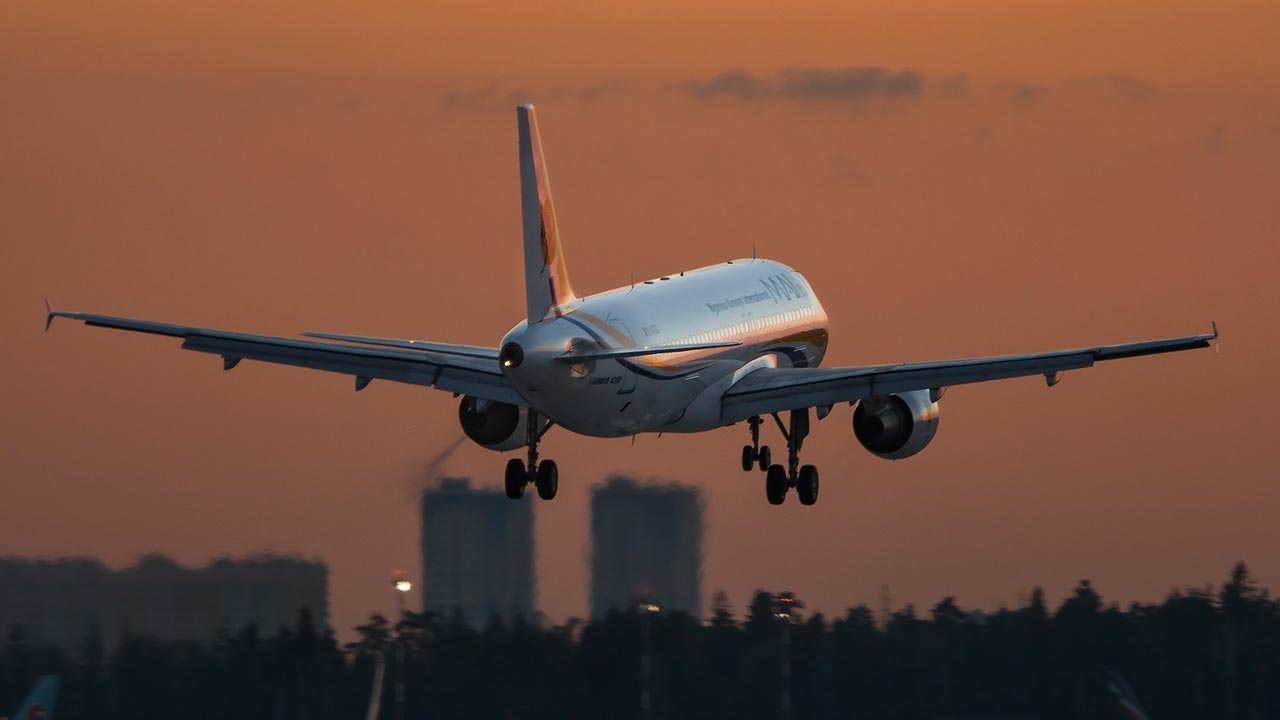
Photo by Papa Dos.
Flying from Bangkok to Yangon
Low-cost flights from Bangkok (Don Mueang Airport) to Yangon take about 1h20 and cost between €100 and €150 — depending on the time of year.
The low-cost airlines with the most frequent flights are:
• NokAir
• Air Asia*
*Tip: install and check the Air Asia app for deals that can’t be found on the website. You can save up to 20% off.
The standard airlines flying frequently to Yangon are:
• Myanmar National Airlines
• Myanmar Airways International (daily flights)
• Bangkok Airways
• Thai Airways International
Transport from Yangon International Airport to the city
As the airport is a 30-minute drive from Yangon, the easiest way to get to the city is by taking a taxi which shouldn’t cost more than 8000 MMK (€ 4.90).
However, buses can save you money if you’re traveling alone or can’t find other travelers to split the taxi fare with. To find the buses, exit the arrival Terminal and cross the parking space. A bus ride to Yangon cost 500 MMK (€0,30).
Flying from Bangkok to Mandalay
Low-cost flights from Bangkok (Don Mueang) will take 2 hours to reach Mandalay.
Transport from Mandalay Airport to the city
Mandalay Internation Airport is a 1-hour taxi ride from Mandalay city center. Fares on taxis with AC cost up to 15000 MMK (€ 9,15), but if you can handle the heat, taxis with no AC are a bit cheaper.
Besides taxis, we’re not aware of any other transportation to the city.
Getting around Myanmar (Domestic Flights)
Myanmar National Airlines have many domestic flights — that even locals try to avoid due to a bad reputation. Flights range from € 50 up to € 250, depending on the destination and time of year. In April during the Thingyan Water Festival, flights sell out super fast.
The most common domestic flights are:
• Yangon > Bagan (Nyaung-U)
• Yangon > Mandalay
• Yangon > NayPyiTaw.
Domestic flights are infamous for leaving earlier than the scheduled time. Also, have in mind that while flying can save you time, you’ll spend a lot more money than traveling by land. If you want to book one of the options mentioned above, check out www.bookaway.com (to get 5% off the price use the code “gravy5″ at checkout).
Cover photo by Hai Yang.
Myanmar Visa for Foreign Travelers (what to know before you go)
You may already know that foreign travelers are required to have a Visa before entering Myanmar. Meaning that, unless you’re from one of the neighboring ASEAN nations, there’s no Visa on arrival for you.
As the Myanmar visa application takes some time, paperwork, and organizing beforehand, we’ve gathered all the relevant (and updated) information so that your trip can get off on the right foot.
Myanmar Visa Application Options
e-Visa
You can apply for a Regular e-Visa or an Express Tourist e-Visa at evisa.gov.mm. With the Express e-Visa, you can have the application process completed in 24 hours. But considering the number of complaints and that it is a recent service, we recommend doing it at least 3 days in advance. Just in case.
What you’ll need to apply for a Myanmar e-Visa
• Passport valid for 6 months
• A recent digital personal photo (48mmx38mm).
• Regular e-Visa cost (3 days): 50 USD
• Express e-Visa cost (24 hours): 56 USD
You can pay with MasterCard, American Express, Visa, or JCB.
Have in mind that not all passport holders are eligible for applying for an e-Visa. You must be from one of the 100 countries that have an agreement with Myanmar. Know more here: evisa.mm/NoticetoTourists (jump over to paragraphs 10 and 11).
e-Visa validity and permitted length of stay
After applying, you’ll be sent the e-Visa approval letter to your email inbox. The letter is valid for 90 days from the issued date, and if it expires, your entry into the country will be denied.
By the time you cross the border, you must carry a printed version of the letter to present to the border officials and get your passport stamped.
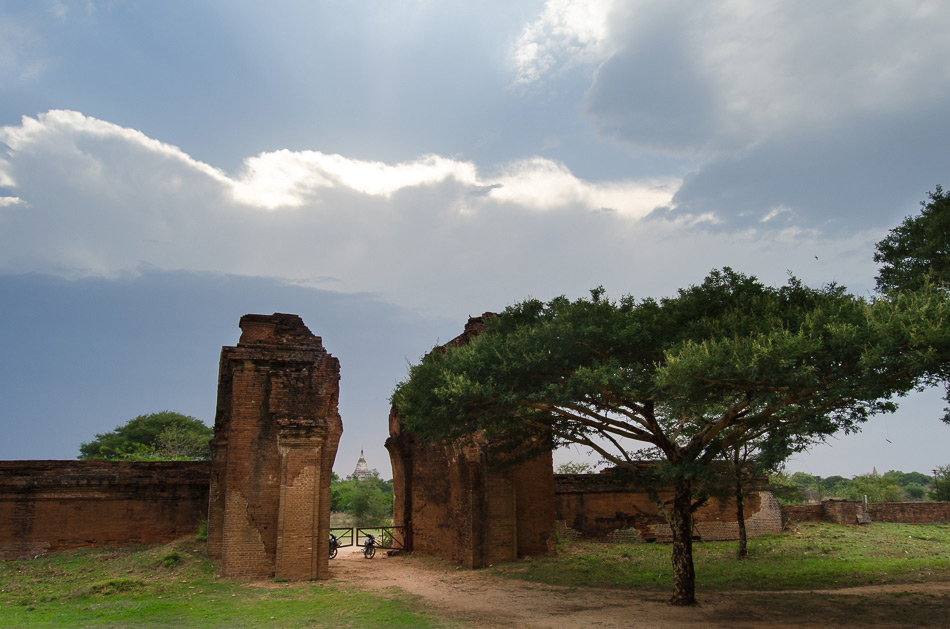
After entering Myanmar you’ll have 29 days to visit the country, and you won’t be able to leave and re-enter without acquiring a new Visa. Nevertheless, your stay can be extended for another 14 days, paying a 3 USD per day fee to the immigration officers at the border (plus an extra fee of 5 USD if you’re leaving through an airport).
There’s a slight problem with overstaying though. Some hotels may deny service to overstayers (as they would be in for a hefty fine should they be caught for allowing that).
e-Visa Entry Permissions
e-Visas will limit how you can enter the country. Currently, passengers with e-Visa are only permitted to enter via following ports:
✈️ Through airplane
• Yangon International Airport
• Mandalay International Airport
• Nay Pyi Taw International Airport
🚌 By land
• Tachileik Land Border Checkpoint
• Myawaddy Land Border Checkpoint
• Kawthaung Land Border Checkpoint
• Tamu Land Border Checkpoint
• Rih Khaw Dar Land Border Checkpoint
If you’re looking for transportation to Myanmar check out www.bookaway.com (to get 5% off the ticket price use the code “gravy5″ at checkout).
Paper Visa
In case you’re already traveling in a neighboring country, you can go over to the nearest Myanmar embassy or consulate. Here’s a list of all the Myanmar embassies abroad: www.embassypages.com/myanmar
Each of the embassies on the list has their own hours to handle Visas. Also, application processes can take from 1 day all the way up to 2 weeks.
Required documents (can change according to your location)
• Passport valid for 6 months
• 2 personal photos (35mmx45mm). The photos should be recent.
• A colored photocopy of your passport
• Proof of the bus or plane ticket into Myanmar
• Proof of a hotel booking*
The cost can vary according to the embassy you’re applying to — to be paid in cash only.
We made our application at the Myanmar consulate in Chiang Mai and paid 1600 THB (49 USD) to have the visas ready in 3 business days. If you wish to have it processed on the same day, you’ll have to pay 2400 THB (74 USD).
Working hours are a bit odd there: 9:30 AM to 11:30 AM.
* The application form asked us to write down the address of the hotel we would be staying in Myanmar. Not having a reservation yet, we wrote down the city and a hotel name that we managed to memorize from a Google search days before. We were not asked for other evidence.

Is a pre-booked outbound flight necessary to enter Myanmar?
Some travel books allege that to enter Myanmar foreigners must have proof of a pre-booked flight leaving the country. On the other hand, many bloggers say they don’t.
The truth is that neither at the moment of our visa application nor at the moment of crossing the border we were asked for that. Apparently, the myth exists due to border regulations providing that possibility — even though it rarely happens.
So in the spirit of reducing the likelihood of that happening check out the article: 9 tips and tricks for a smooth border crossing.
Vaccination requirements for entering Myanmar
The vaccine is mandatory if you’re arriving from a country with a risk of yellow fever. Check the updated list to see if you’re required to get it: countries with risk of Yellow Fever.
If you have any questions regarding Myanmar visas, use the comments below. We might be able to answer.
Cover photo by James Antrobus.
What to visit in Mandalay Archeological Zone
To help you make the most out of your time in Mandalay, here’s our selection of temples and sites you shouldn’t miss. Most are within walking distance of each other — like the ones at the foot of Mandalay Hill — and the farthest ones are only a quick taxi or bicycle ride away.
Mandalay Palace
⏱️ You’ll need at least 2 hours to see the Palace complex.
Ticket fee
If you’re planning to visit more than just the Mandalay Palace, you can purchase the Mandalay Archaeological Zone Combo Ticket for €6.15 (10,000K). It’s valid for one week.
It’s not clear what monuments this ticket gives you access to. And even though it should be stamped at the entrance of every monument you visit, our tickets were only checked at the entrance of the Royal Palace and the Shwenandaw Monastery.
The Palace Complex
Located near Mandalay Hill, the Palace is inside a walled fort and surrounded by a 20-meter wide moat. Visitors can only use the entrance on the east side through a gate guarded by armed men.
These days the palace complex consists of several wooden buildings rebuilt in 1990 after it’s destruction during World War II. Nevertheless, most buildings remain closed to the public, and the few ones opened are poorly lit, completely empty and a bit smelly.
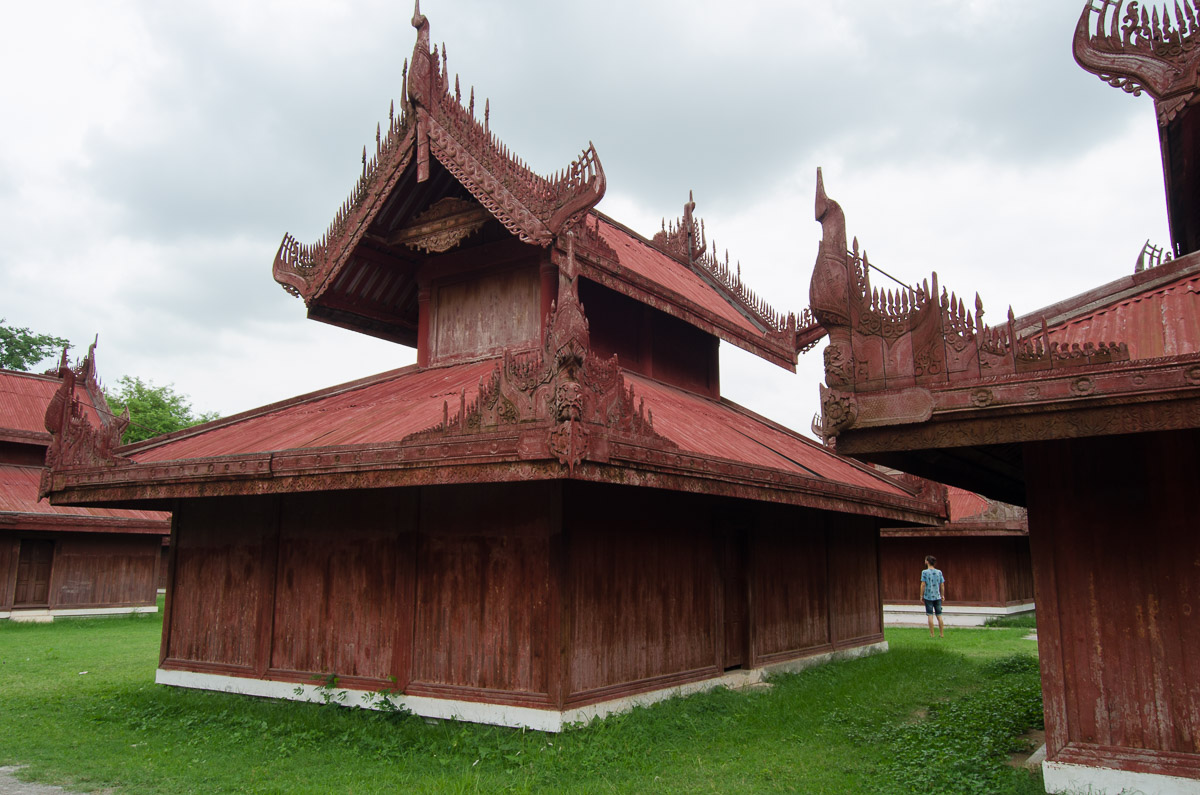
Even though it’s an important part of the country’s history, we found the complex to be uninspired and dull. However, we felt like the view from to the top of the watchtower compensated for all other visit restrictions.
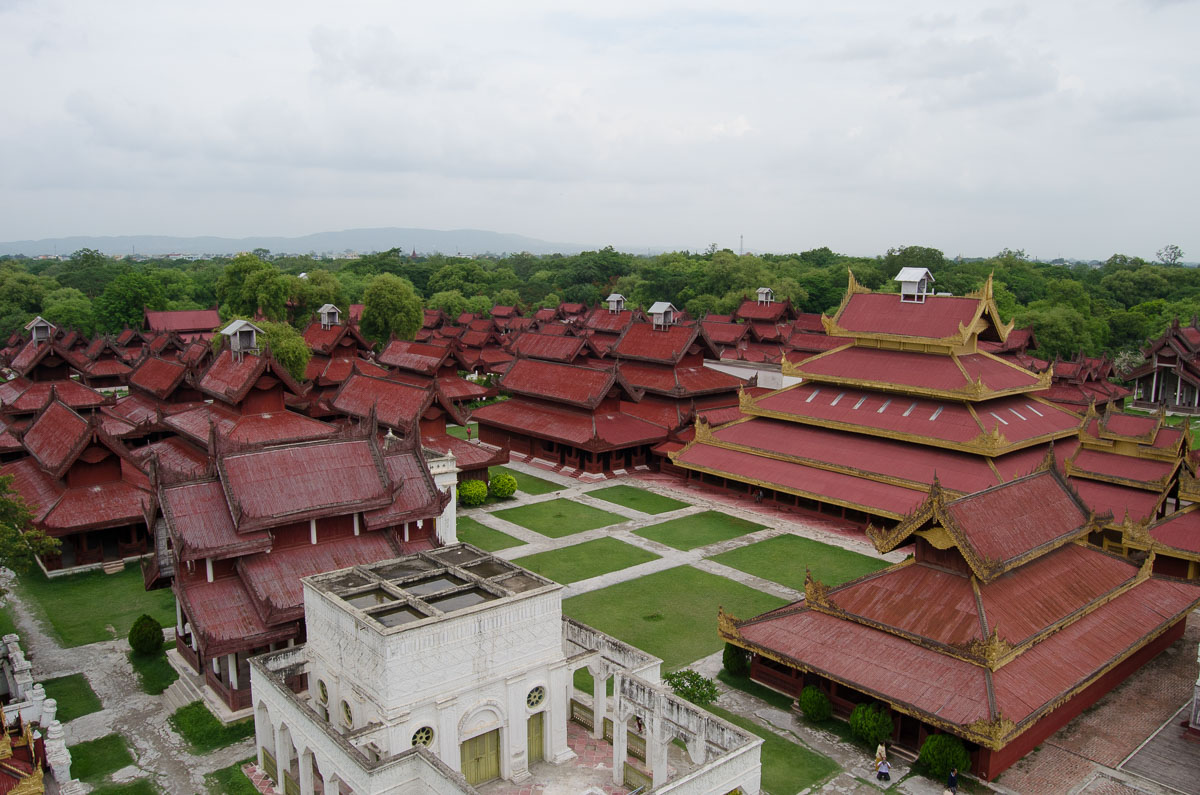
Mandalay Hill
Entrance fee
It’s supposed to be free, but if you’re a foreigner you’ll be charged 1000 MMK (€0.63) for a permit to take photos.
Climbing the hill on foot (not an easy task)
Right at the beginning is a sign asking you to climb the stairs barefoot — do so.
Along the way, you’ll find several stalls: some selling knick-knacks, some selling snacks. You’ll see small temples with buddha images, viewpoints overlooking the city, and stairways that never seem to end.
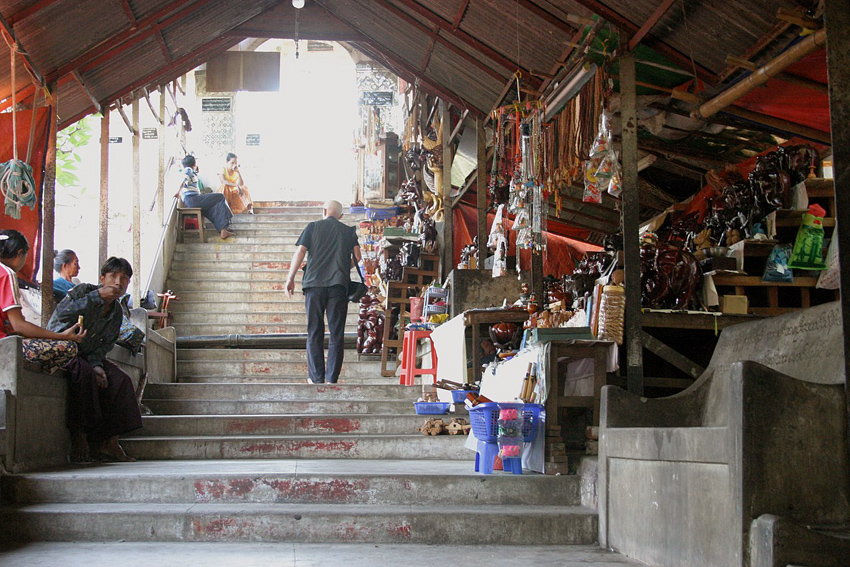
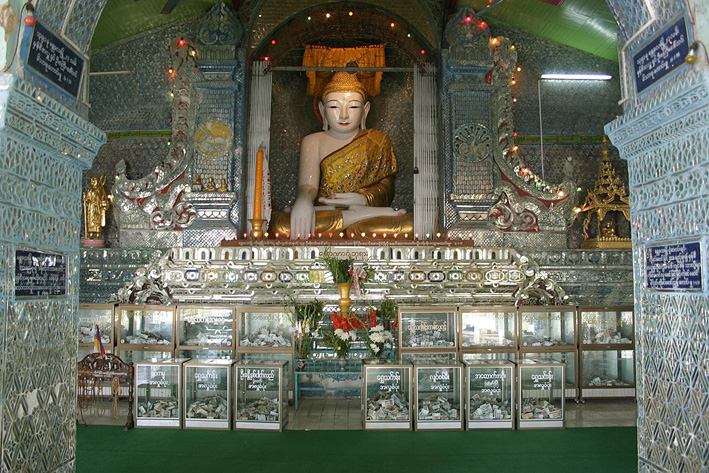
After 20 minutes we guarantee that you’ll regret your decision, as the 240 meters climb of stairs will feel like hiking through the Kilimanjaro. Yet, if you’re lucky to do it on a mild day, you can reach the top in 30-40 minutes.
What’s up there
At the top of the hill is the Sutaungpyei Pagoda, where you can rest and observe the many locals practicing the Buddhist ritual of pouring water over the Buddha statues.
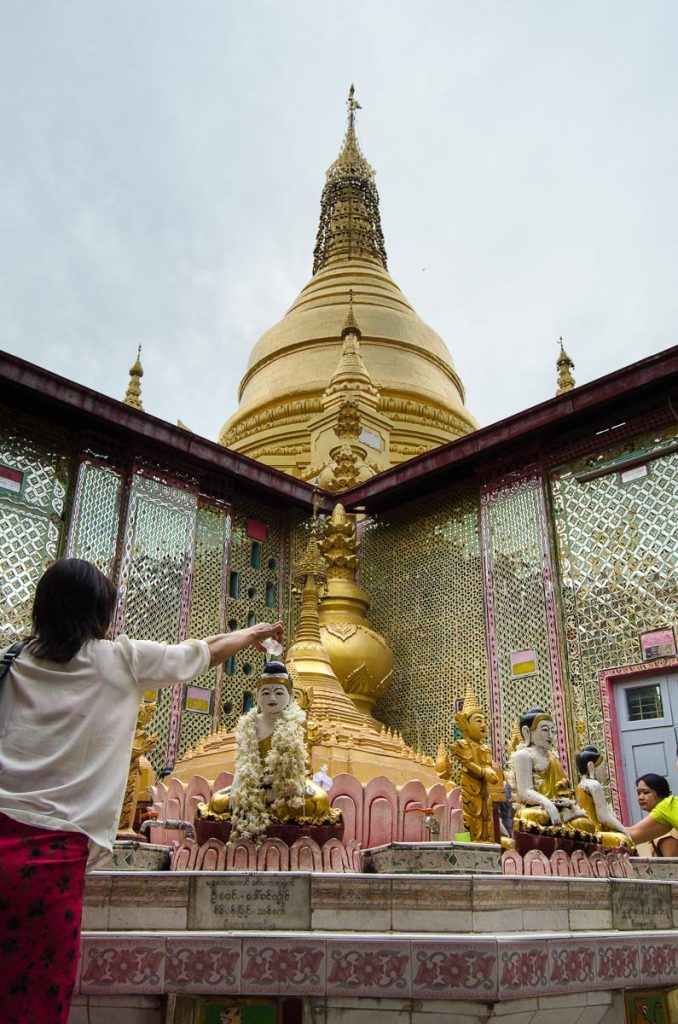
But the real reward for the struggle of climbing the hill is the stunning panoramic view that stretches for miles. The big Irrawaddy River reflecting the sun, the city melding with the trees and the green with the gold of temples and stupas.
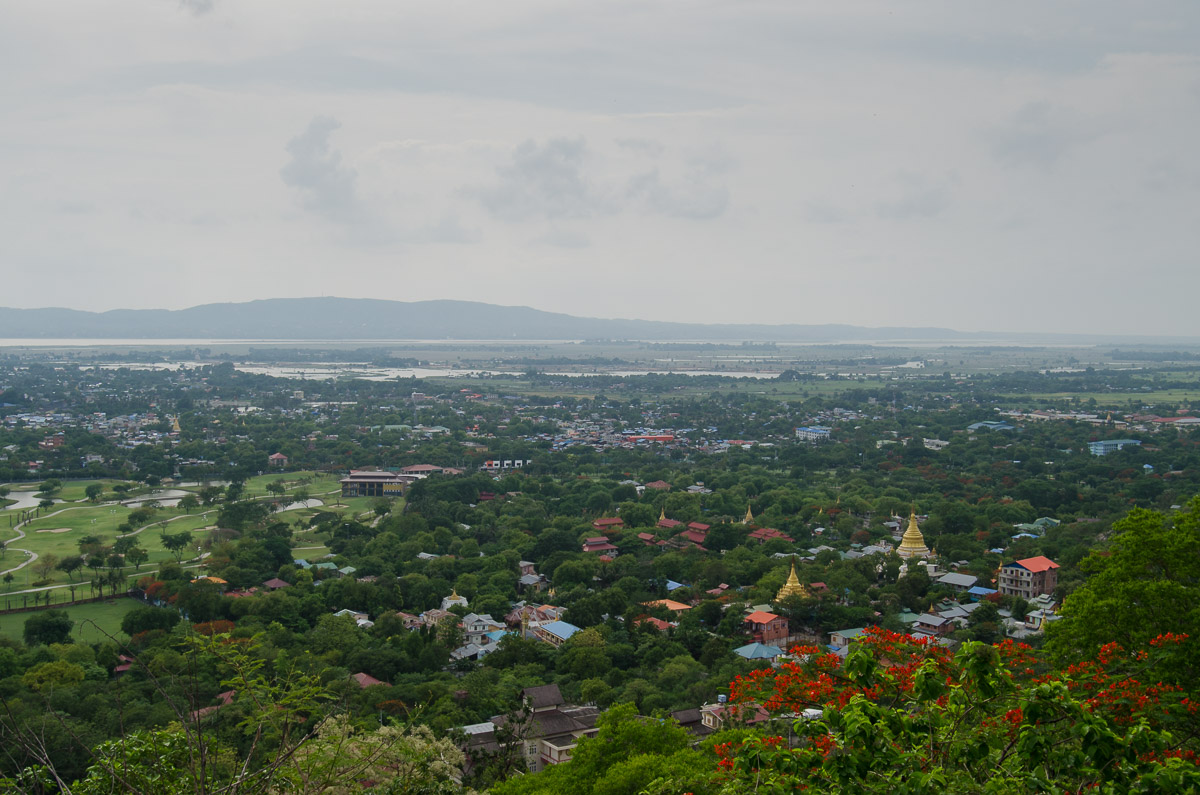
Alternative transport to get to the top (easy task)
If you’re short on time — or simply pass the quad workout from climbing all those stairs — share a motorbike taxi for 1000 MMK (€ 0.63), or 5250 MMK (€ 3.07) to go alone. It’ll leave you at the top entrance.
Temples at the foot of Mandalay Hill
The surrounding area of Mandalay Hill is also rich in Buddhist sites and monuments. Here are the 5 temples we recommend (our tickets weren’t checked at any of these):
Atumashi Monastery a.k.a. Atulawaiyan
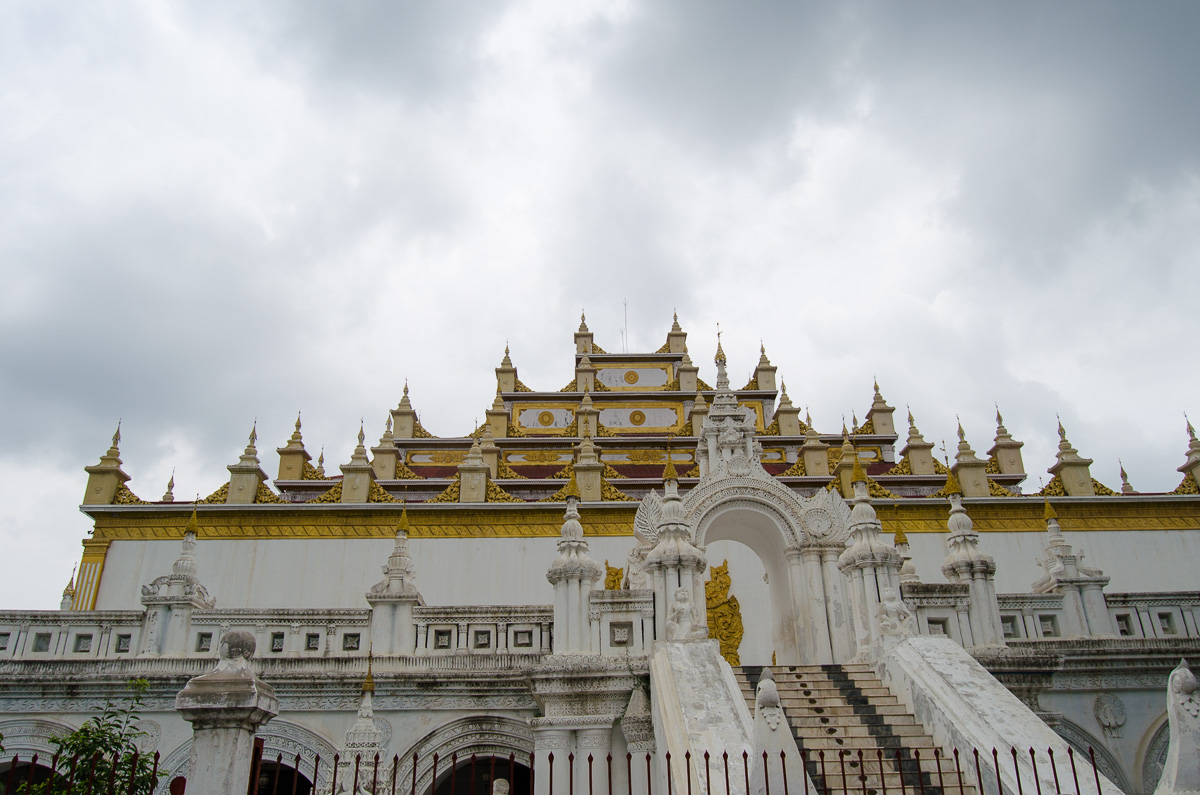
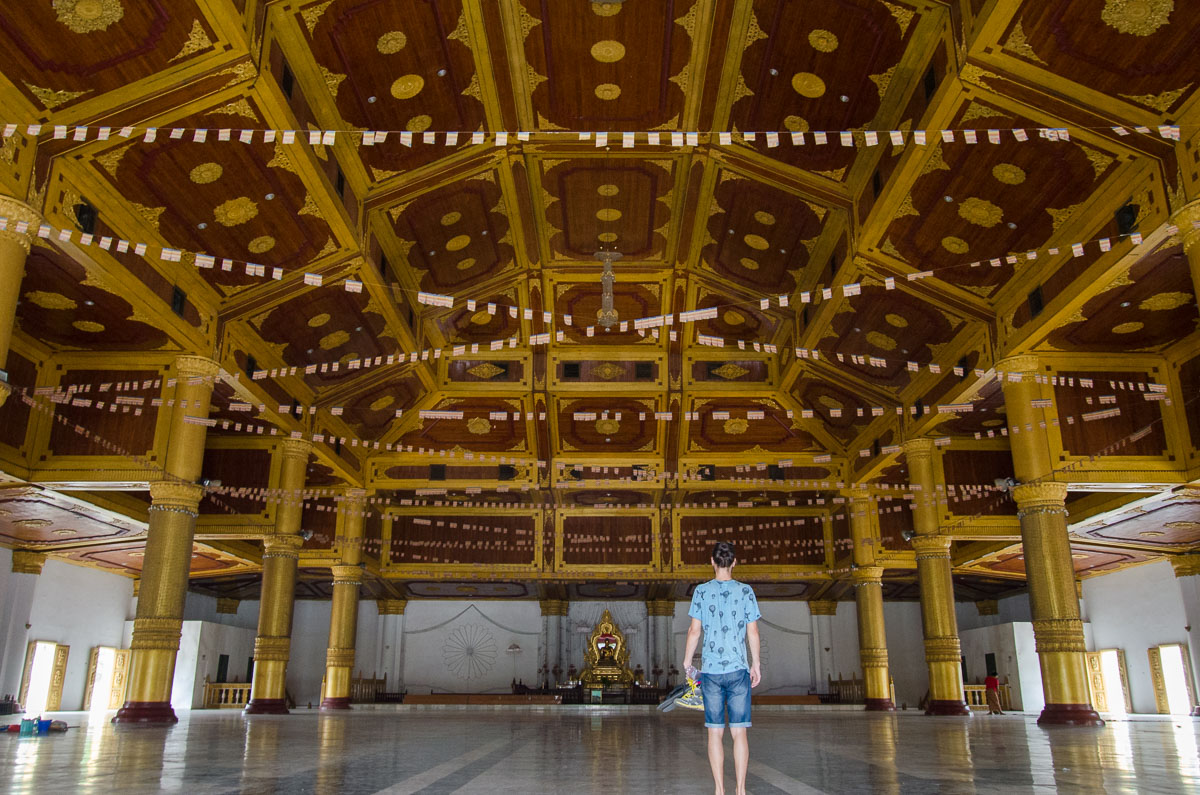
Shwenandaw Monastery
An all-wood monastery decorated with low reliefs of animal figures, floral ornaments, and Buddhist stories. This temple was brought from Amarapura and rebuilt here.
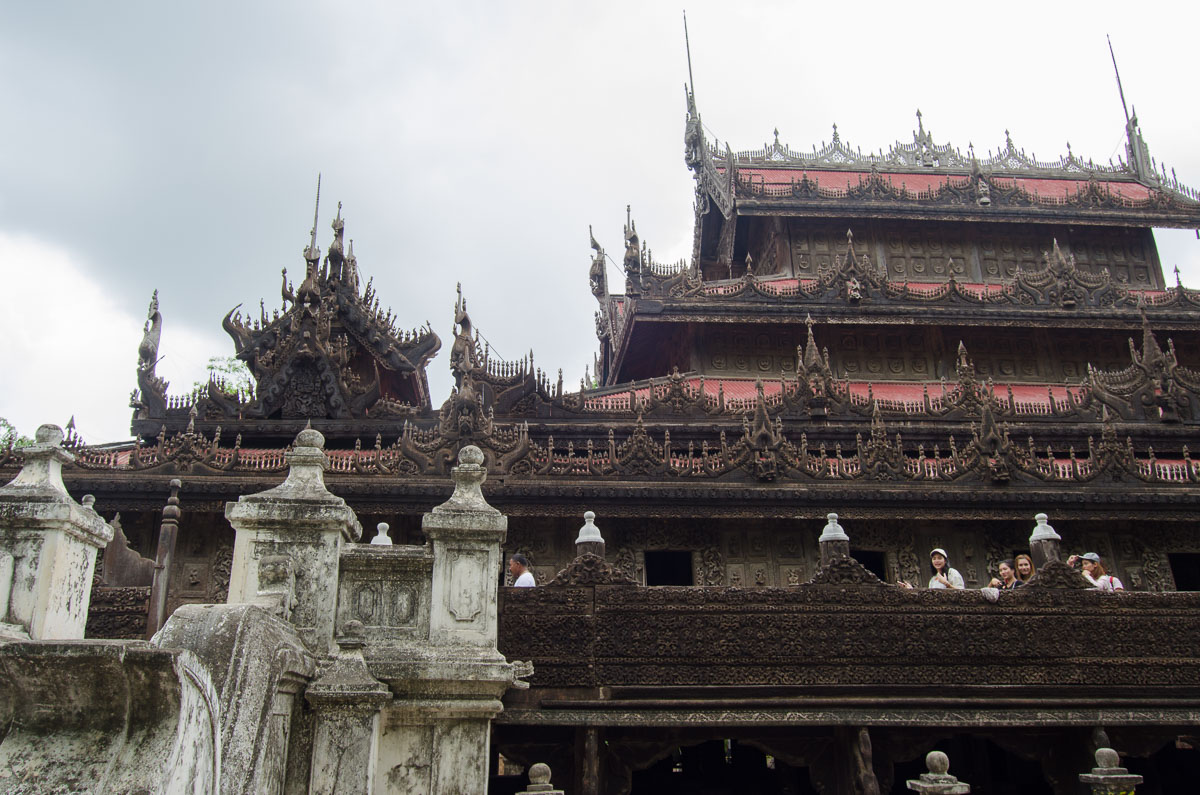
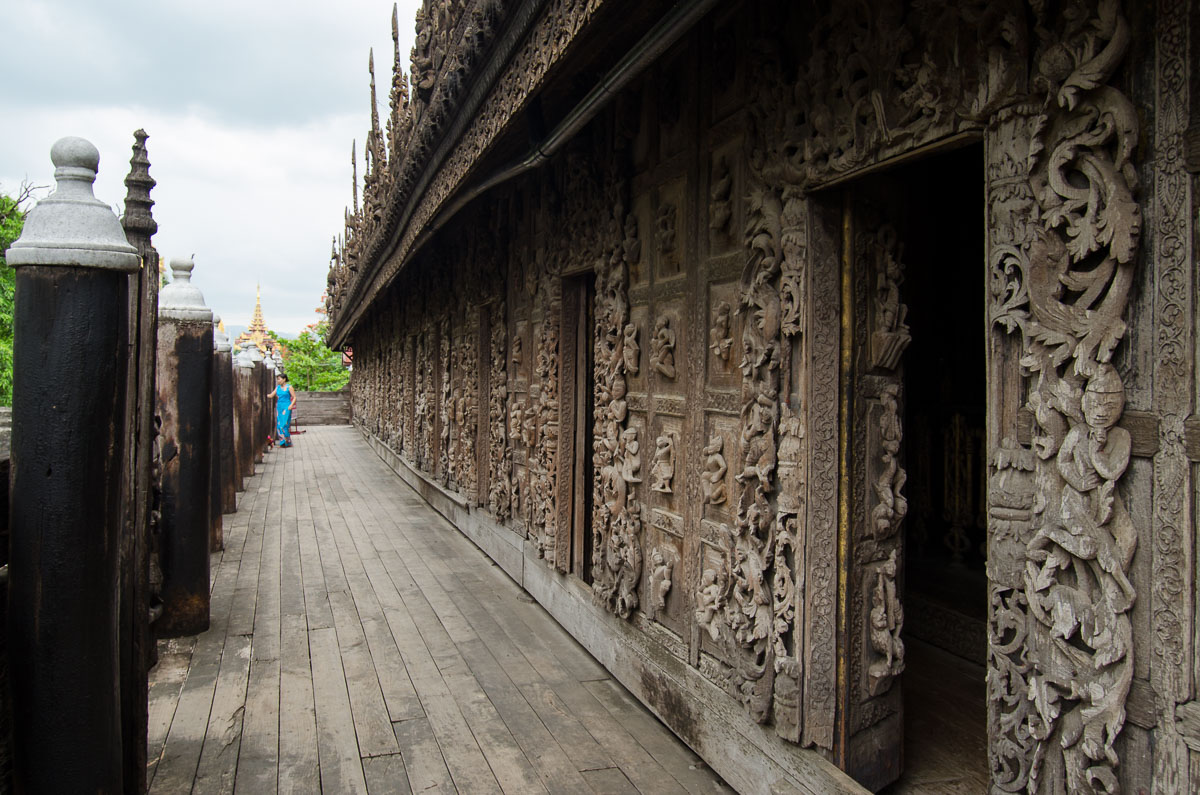
Kuthodaw Paya
A beautiful temple referred to as “the world’s largest book” where the pages of Tripitaka (the guiding principles of Theravada Buddhism) are engraved in marble blocks. The blocks are protected by 729 small white altars, organized around the large central golden stupa.
A must-visit.
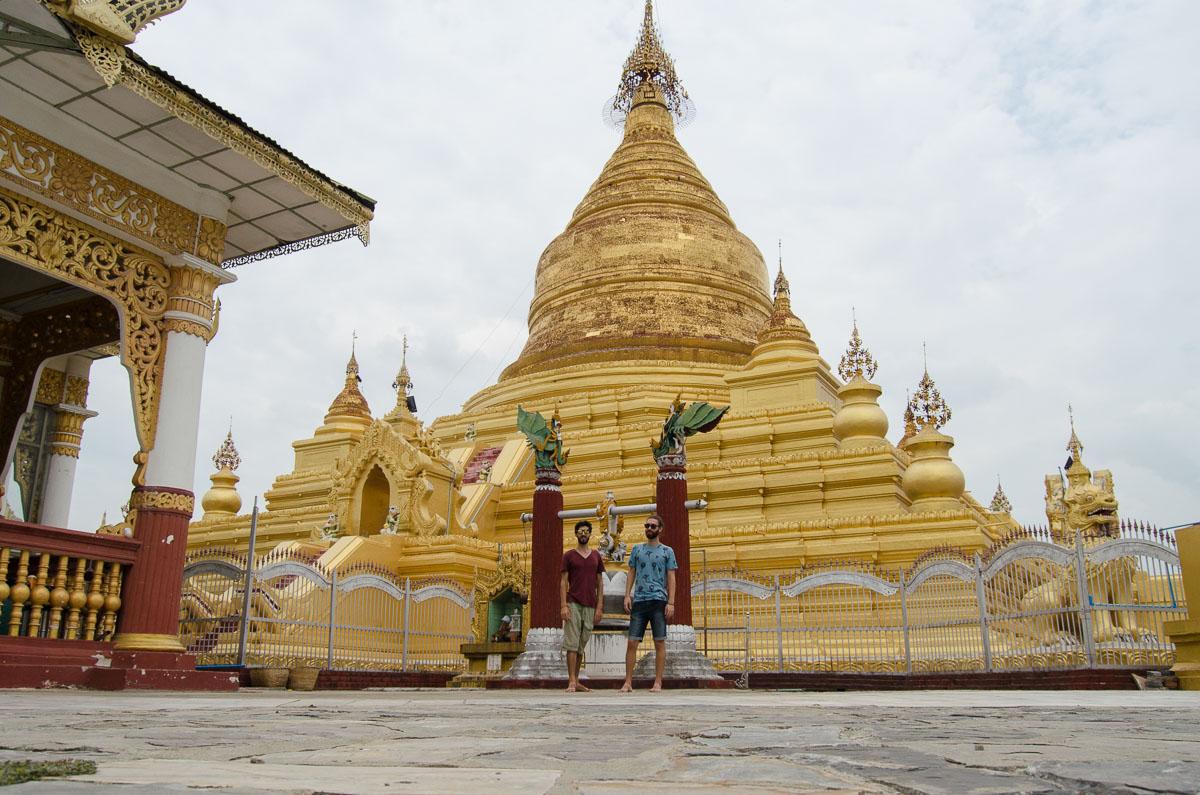
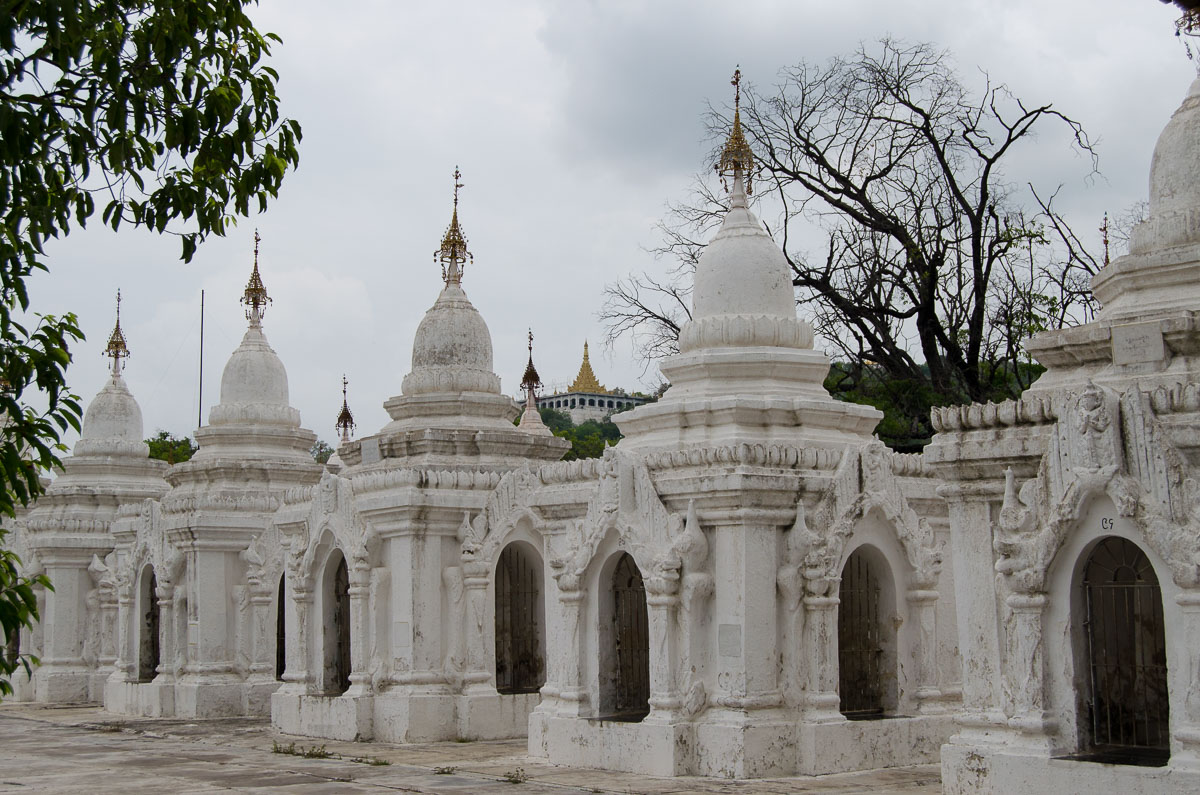
Sandamuni Paya
The Sandamuni temple bears a resemblance to Kuthodaw, but it’s known for housing the largest iron Buddha image in Burma.
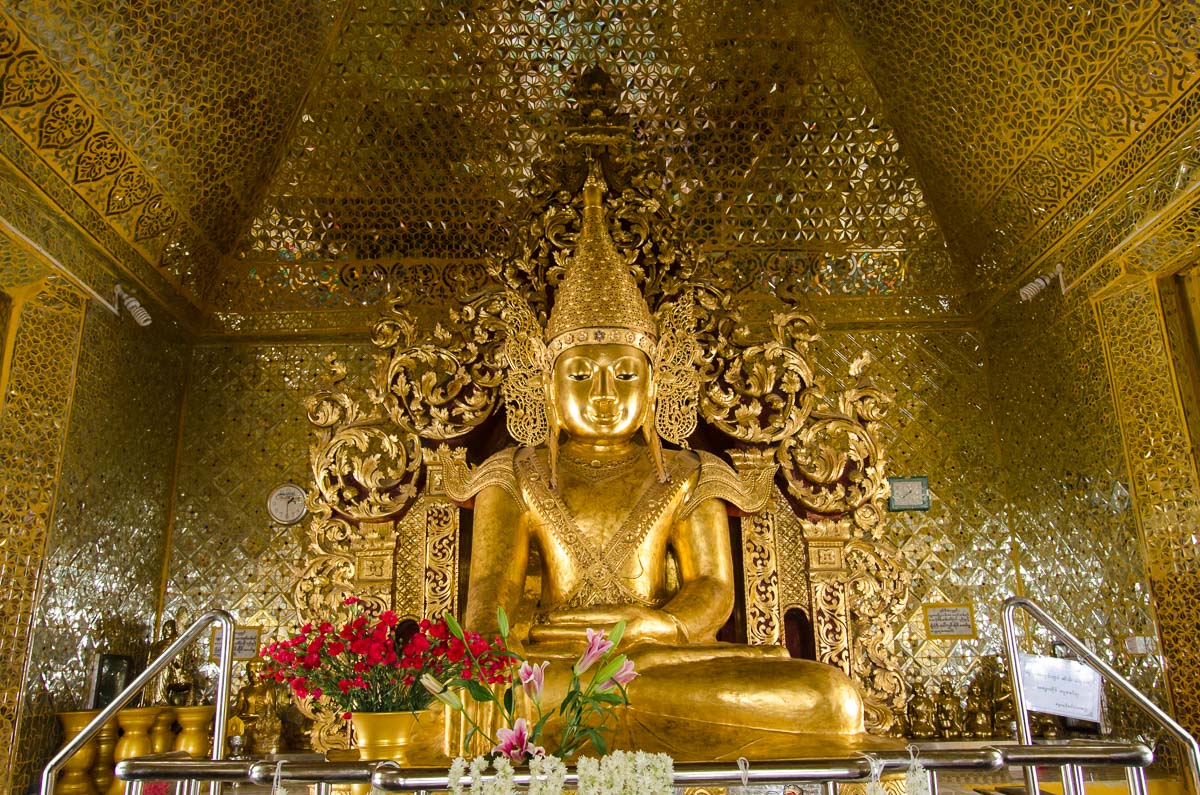
Kyauktawgyi Buddha Temple
At the south entrance to Mandalay Hill is the Kyauktawgyi Buddha Temple. There’s a statue of the seated Buddha carved into a single block of pale green marble, extracted 19 km from Mandalay and brought here by the force of men.
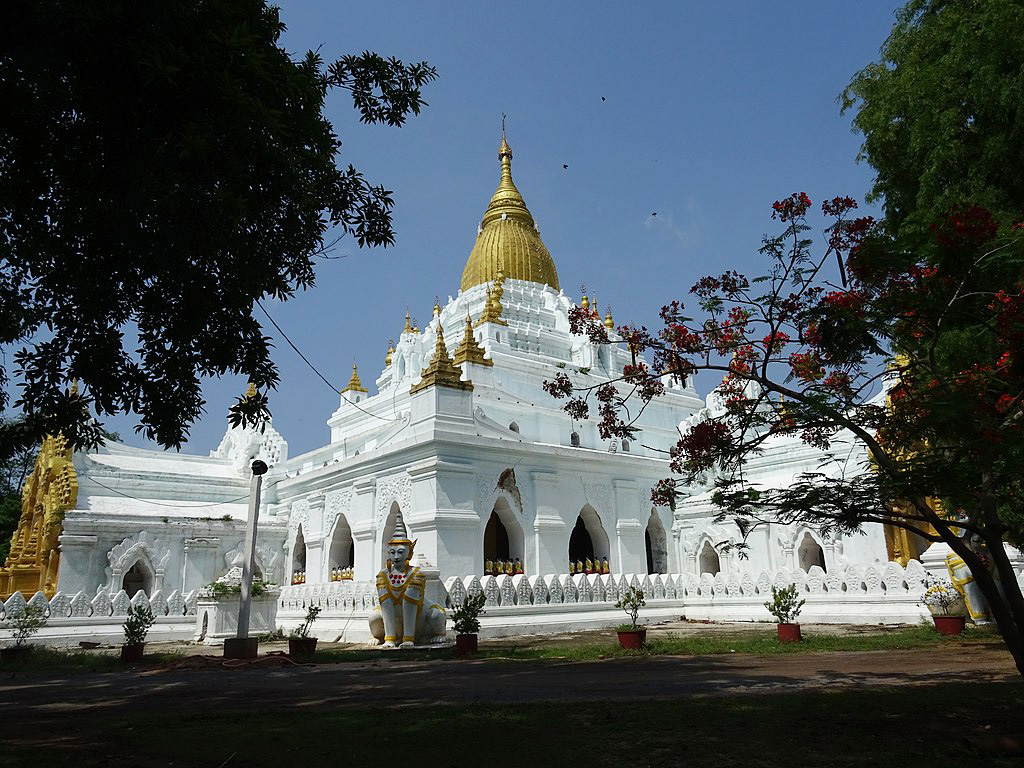
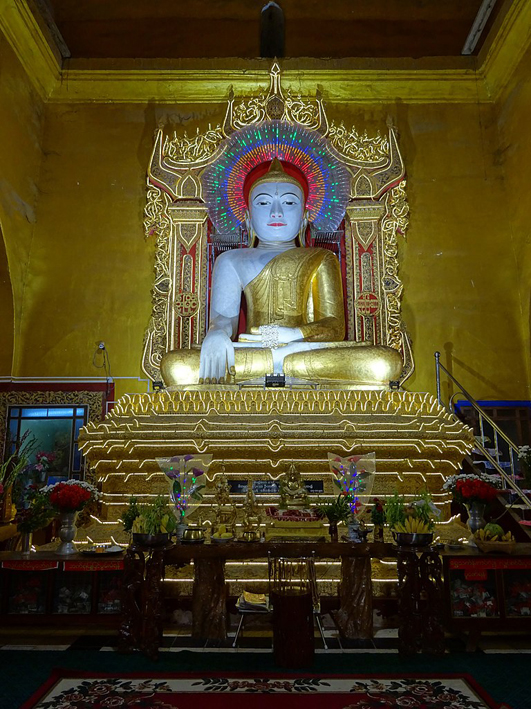
Must-see temples around town
Maha Myat Muni Paya
One of the most visited temples in the southwest of Mandalay, known for its 4-meter gold-covered Buddha statue, believed to be 2000 years old and covered by a 15 cm layer of gold. The Buddha’s face is polished daily at 4:00 pm.
For about 1600 MMK (€ 0.98) you can add one gold leaf to the statue. But only men are allowed to do it.
Shwe In Bin Kyaung Temple
In the south of Mandalay, you’ll find the far less popular (but equally beautiful) temple of Shwe In Bin Kyaung. The temple stands out for its beautiful wood carvings and teak structure.
Note:
All temples mentioned above can be visited with the Mandalay Archaeological Zone Combo Ticket.
The 6 Best Markets in Chiang Mai (from Popular to Obscure)
For many centuries, Chiang Mai had an important role in Thai commercial relations with China and the Burmese Kingdom. And these days, considering the number of open-air markets scattered all over town, we could say that trading heritage is still alive. Consequently and to honor that tradition, we’re showing you 6 of the best markets in Chiang Mai.
We aimed for diversity here: there are 3 popular markets, and 3 alternative shopping experiences (the type of market where you won’t find temple pants).
1. Chiang Mai night bazaar
Open: every day, from 6 PM to 10:30 PM.
Location: the intersection of Tha Pae and Chang Klang Roads.
The Chiang Mai Night Bazaar is one of the oldest evening markets in Thailand. These days is known as the best spot to buy fake designer goods: from shoes and clothing to fake Rolex and sunglasses.
Have in mind that around here, tourist are the main targets of the vendors so prices will be marked up at least 20%. Get ready to bargain!
But Nuno and I share the opinion that the real cultural experience is in the food and drinks area — especially if you like to eat al fresco. There are an array of stalls selling every street food you can imagine, sweet Thai snacks (like banana roti, mango and sticky rice, fruit smoothies), western style restaurants, and bars. All next to a gardened area perfect to socialize and watch the street artist perform.
2. Sunday Night Market (or Walking Street Market)
Open: every Sunday, all year round, from 4 P.M to 00.00 A.M.
Location: mainly on Ratchadamnoen Road in the center of the walled city, but keeps spreading down many side streets as it gets bigger every year.
Every Sunday afternoon, Ratchadamnoen Road closes to traffic allowing you to walk around without the constant fear of cars. However, that doesn’t mean you’ll experience a relaxed atmosphere.
The Sunday Night Market is the most popular shopping spot in Chiang Mai (both for locals and for tourists) and it can get a bit overwhelming.
Yet, unlike other popular Asian markets, the products on display stand out for its quality and craftsmanship once you filter out the generic bric-a-brac. That’s why it can be the perfect place to purchase souvenirs: you’ll find work from local artisans at great prices.
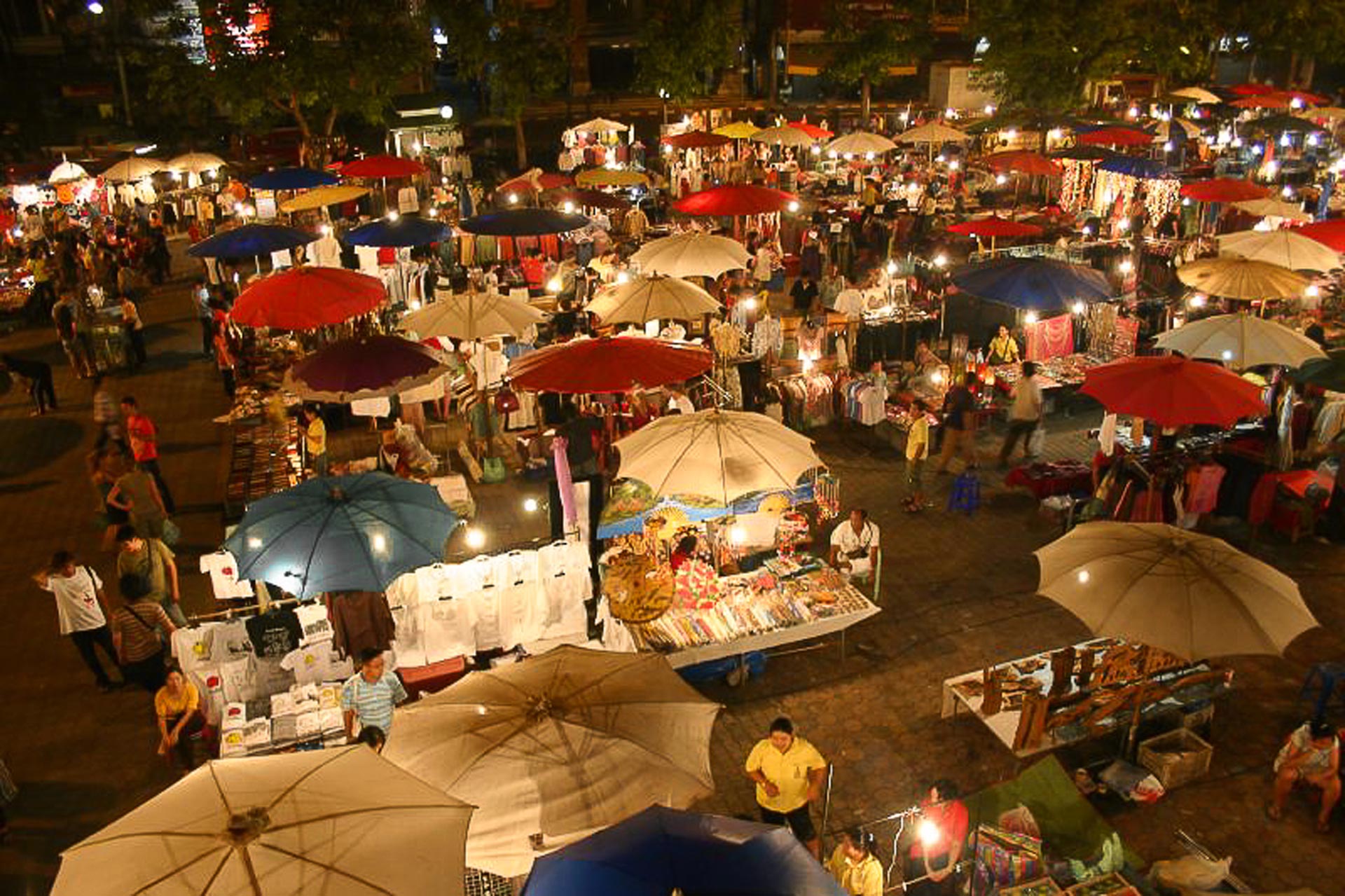
But if you’re more interested in the food and entertainment, there’s plenty of that as well. Multiple areas are dedicated to food, so ensure your stomach is empty before arrival. The shows, street entertainers, and musicians start performing after dark on the stages featured either side of the main road.
3. Warorot Market (Kaad Luang) Central Market
Open daily from 06 A.M to 7 P.M.
Located: at the Chang Moi Road, north of Nawarat Bridge near the west side of the River Ping.
Warorot Market (or Kad Luang as locals call it), is less touristy and confined to and around a three storey building, and the goods are organized by floors:
Ground floor: produce and food, particularly Northern Thai dishes such as grilled sausages, sweet curries, crispy pork skin.
Second and third floors: clothing and personal care products.
Alleys around Warorot Market: textiles, hill tribe handicraft, and the beautiful flower market Ton Lamyai.
Here’s where Thais do their shopping: from fresh produce to fireworks, and that’s why a visit to Warorot can be an immersive experience into the local way of life.
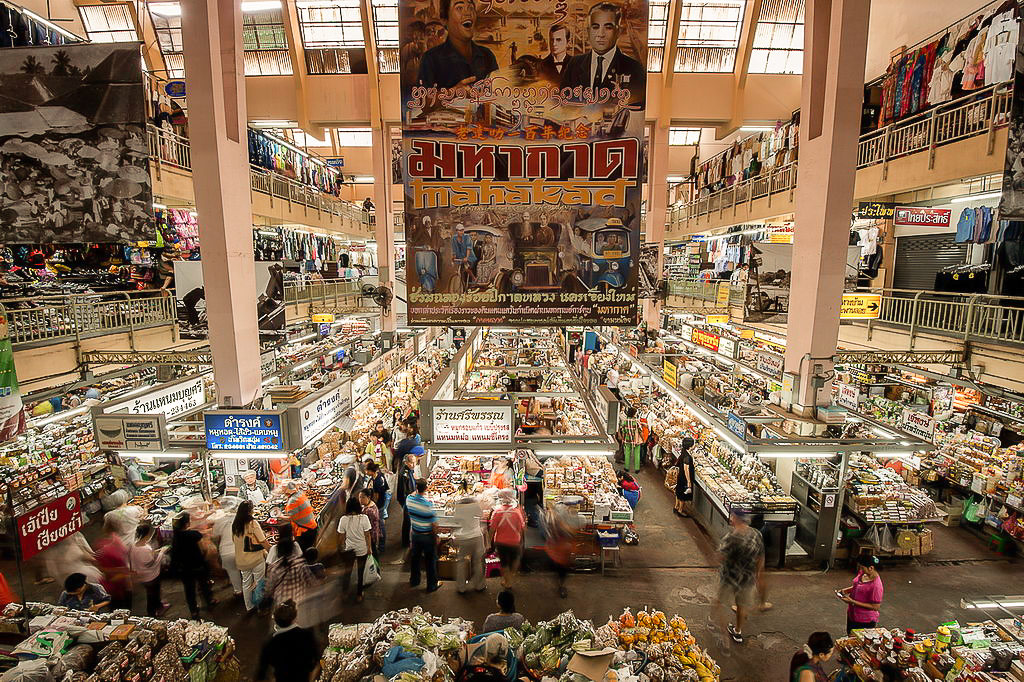
Plus, and as you might expect from a non-touristy place, prices are much cheaper so there’s no need to bargain for a discount.
4. Flower Market (Ton Lamyai)
Open 24 hours a day, Mondays to Sundays.
Best time to visit: early mornings.
Location: Thanon Praisani, next to Warorot Market, along the River Ping.
If you’re an early bird looking for a pleasurable market experience in Chiang Mai, head up to Ton Lamyai. This vibrant bazaar specialized in flowers is a beautiful way to start your day.
Piles, bouquets, and garlands of fresh blossoms arrive from farms around Chiang Mai in the early hours of the morning, adorning Ton Lamyai with exotic colors and the fragrance of a thousand flowers (so make sure to take an antihistamine before).
5. The Amulet Market (Kad Kham Tieng)
Open: Thursdays from 7 A.M to 2 P.M
Location: north of the Old City off the Superhighway behind Tesco Superstore.
Kad Kham Tieng is one of the most intriguing bazaars in Chiang Mai and the in-spot for all superstitious people. As most Thais believe that good luck, protection, and fortune can be influenced by wearing ‘charged’ amulets, the inventory around here is quite strange:
• Eyebrow hairs from special monks
• Incense ashes
• Monk blood
• Scarves with magic spells
• Pollen
• Old opium pipes
And thousands of other options — all spiritually charged by ceremonial chanting.
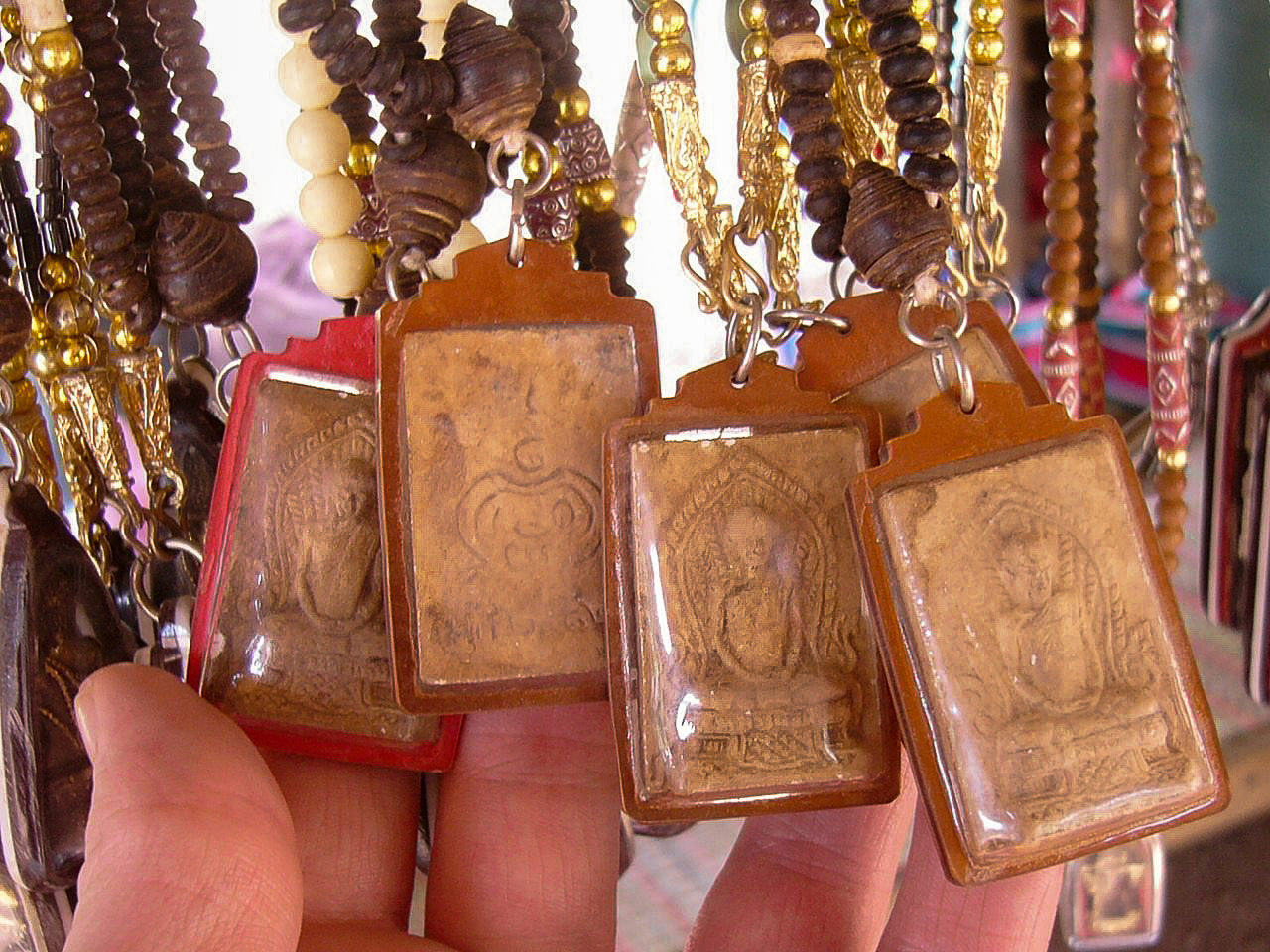
The amulet prices can go all the way up to 10 million bahts when considering its rarity, the monk that performed the ceremony, and the temple that ceremony was held.
Kad Kham Tieng may not a very large market, but it is a unique spot to spend your Thursday mornings in.
6. Jing Jai Organic market
Open: Wednesdays, Saturdays from 6 AM to 9 AM and Sundays from 6 AM 12 PM.
Location: 45 Assadathon Road, Chiang Mai
For the health conscious people wanting to move away from the touristy markets, Jing Jai is the best option. On Wednesdays, Saturdays, and Sunday mornings the market complex becomes a source for everything organic and locally grown: food, vegetables, fruits, and fresh pressed juices.
On Mondays, Tuesdays, and Fridays from 10 AM to 18 PM, you’ll still find a similarly relaxed atmosphere in the area, but there’s no Organic market. There are coffee shops and restaurants to sit back, and a few vendors selling second-hand furniture and antiques. In the evenings, the surrounding area comes to life with a myriad of outdoor Thai-style bars.
If we missed your favorite local market, feel free to shoot us a note in the comments!
The lineup for Chiang Mai Festivals (Year round Program)
Brahmanic, Buddhist, and Lanna heritages endowed Chiang Mai with a plentiful array of cultural expressions. Over time (and thanks to a community with artistic aptitude), traditions evolved into festivals and celebrations that won the hearts of Thais and the interest of the world.
Planning a visit to Chiang Mai? Festivals spread out year round, so there might be one coinciding with your visit. Check the program below:
January. Bo Sang Umbrella & Handicrafts Festival
When:
Every year on the third weekend of January, for 3 days.
Where:
Bo Sang, a village 9 km southeast of Chiang Mai.
How to get Bo Sang:
By songthaew or by bus (White Bus). You can catch either near the river by Warorot Market. The trip takes 25 minutes and should cost roughly 20 THB.
Bo Sang is home to skilled craftspeople in the making of rice paper fans, lanterns, and umbrellas. During the festival, the village streets and alleys are illuminated by lanterns, while hundreds of paper parasols decorate the outside of houses and shops.
It all gets particularly magical after the sun sets, so take the time to go for a night stroll and visit the umbrella making shops.
What to expect:
• Old school carnival games,
• Umbrella making workshops,
• Umbrella painting competition (locals compete to win the year’s most beautiful umbrella),
• Concerts,
• Lanna style dancing performances,
• Parades (2:00 PM)
• Northern Thai food festival,
• A local beauty pageant.
February. The Chiang Mai Flower Festival
When:
On the first weekend of February (1, 2, and 3 of February 2019)
Where:
The key spot is Nong Buak Haad public park.
The Flower Parade goes through Nawarat bridge to Thapae road, Kotchasarn Road, Changlor Road and Arak Road.
Running for over 40 years, the Chiang Mai Flower Festival is a 3-day celebration that showcases Chiang Mai’s unique flowers and plants (all in full bloom at the beginning of February).
What to expect:
• Rare flowers exhibitions,
• Dancers and entertainers,
• Musical performances,
• Plenty of Thai food and drinks,
• Miss Flower contest,
• The Flower Parade.
Photo by Devon Sampson
On Saturday morning (starting at 8 A.M), the long-awaited Flower Parade goes out to the streets. Floats are decorated with millions of natural flowers and accompanied by dancers in traditional costumes.
The floats are considered the highlight of the event. For many months in advance, thousands of locals participate in the building of the floats, making them items of great pride to the community.
As many Thais travel to Chiang Mai for the festivities, streets are not the only place that gets packed with people — so do accommodations. Make your reservations in advance!
Where:
Lanna Rock Garden in Hang Dong, south of Chiang Mai.
When:
February 2, 3, and 4.
Ticket price:
850THB (1-day ticket)
1.500THB (2-day ticket)
1.900THB (3-day ticket)
You can camp there for free if you take your own tent.
Jai Thep is a family-friendly festival created by a collective of artists, and defined as a “3-day celebration of art, music, and magic”.
Along the enclosure of the event are 4 stages occupied by bands and DJs from Thailand and the international scene.
Music genres:
• House
• Drum’n’bass
• Psytrance.
• Electro-chill
You’ll find hundreds of art installations and a great number of creative workshops that’ll suit adults and children.
For more information on Jai Thep go to www.jaithepfestival.com
April. Songkran the Water Festival
When:
April 13th, 14th and 15th 2018.
Where:
All over the city center, but the key celebration spots are near the Tha Pae Gate.
Marking the new solar year, the high energy ceremonies last for 3 days, and they’re the perfect time to let the child in you come out and play. The most popular custom of Songkran is the water fights all over town.
Have in mind that what to us Westerners seems like a good laugh, represents to Thai people the purification of the body and soul. Songkran is a beloved symbolic tradition, therefore some etiquette is required:
• Don’t take your shirt off, no matter how soaked or how hot it is that day
• No bikinis and no short-shorts.
• Don’t through water to monks, babies, and the elderly.
Tip:
Being the most anticipated public holiday for Thais, expats, and backpackers, book your accommodation early.
November. Yee Peng and Loi Krathong Festivals
When:
during the full moon of November, so the date is subject to change. If you write “Loy Krathong” on to Google, you’ll get the correct date for that year.
For 2018 the dates are November 21, 22 and 23.
Where:
Tha Pae gate, particularly between the Nawarat and Iron Bridges.
Loi Krathong or Festival of lights is celebrated for 3 days, once a year. Most ceremonies take place in the evening on various venues throughout Chiang Mai.
What to expect:
• Lantern procession,
• A beauty pageant,
• Parades,
• Boat races on the Mae Ping river,
• Krathong making competitions,
• Lantern release
• Krathong launch
The day before Loi Krathong takes place the Yee Peng ceremony. People decorate their houses, temples, and streets with paper lanterns of many shapes and colors.
At night the paper lanterns are lit and tossed into the air, carrying a wish for good fortune in the new year.
Simultaneously, on the Mae Ping river are released hundreds of krathong (baskets made of banana leaves, adorned with incense and candles), to honor the Water Spirit.
The krathong symbolizes letting go of all sins and misfortunes of the previous year.
Extra
For on and off festivals and upcoming events, check the website: City Now!- Chiang Mai.
Cover photo by Rodney Ee
